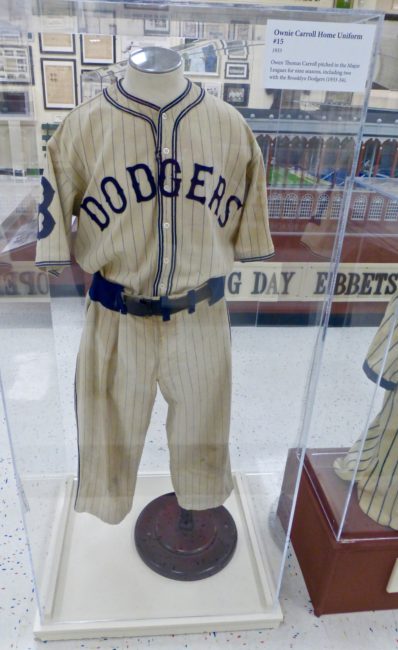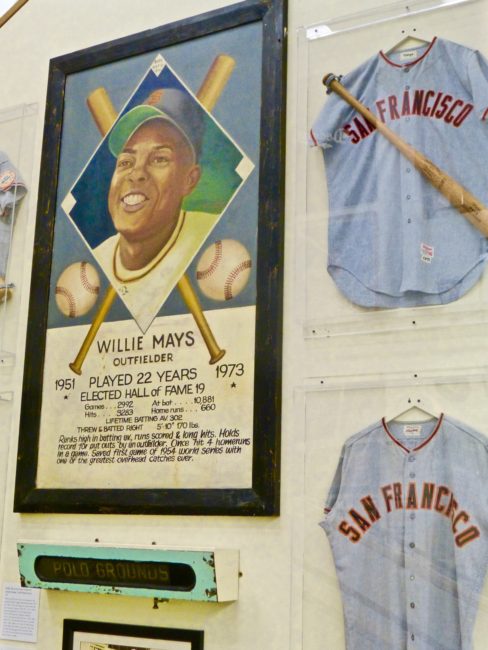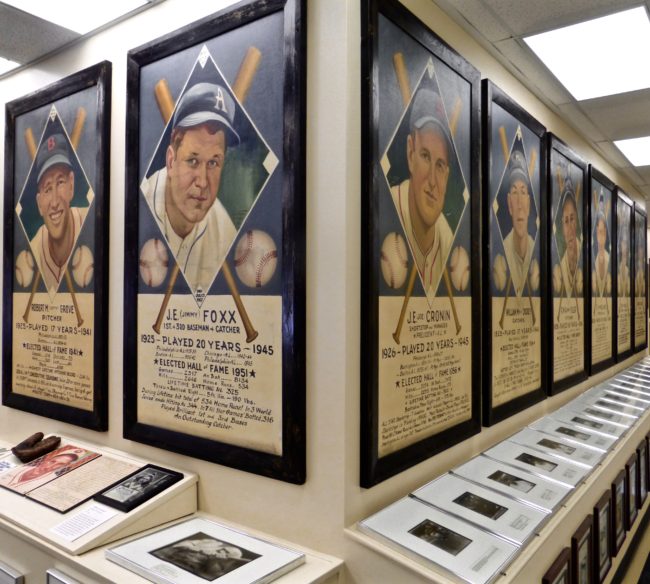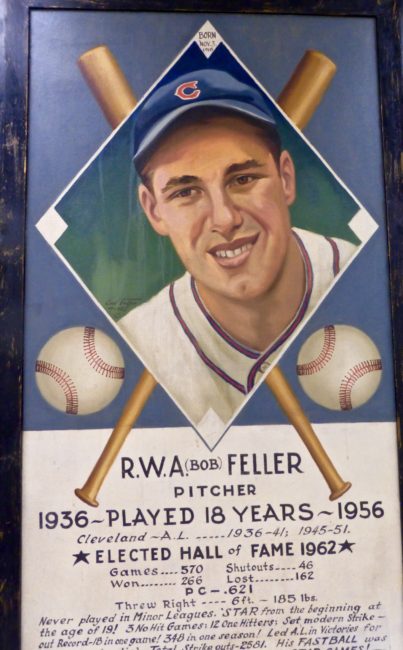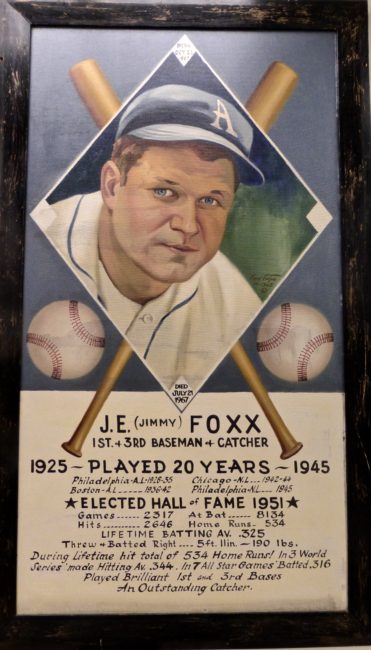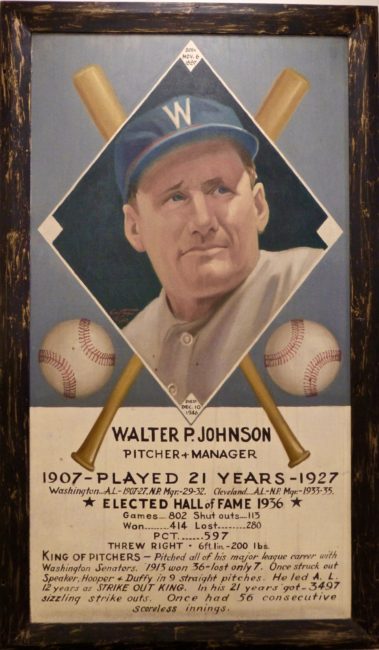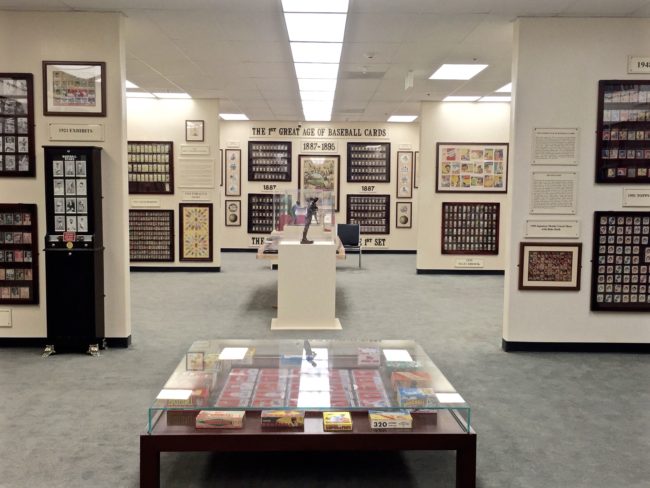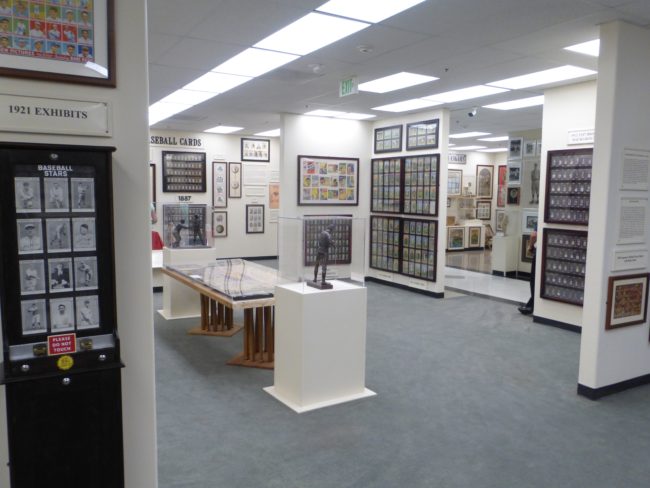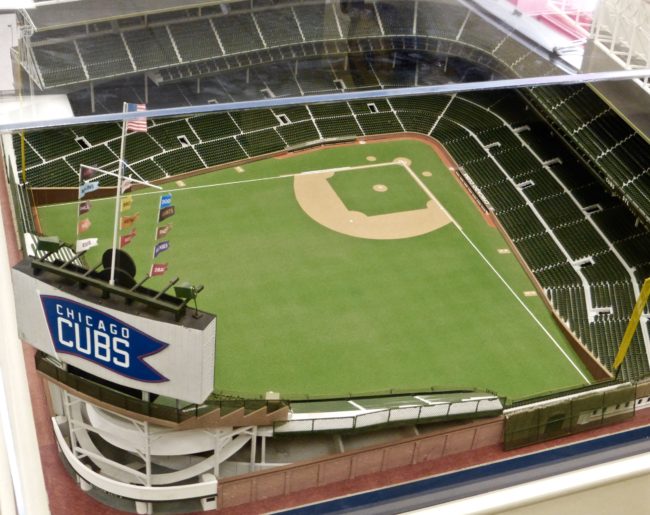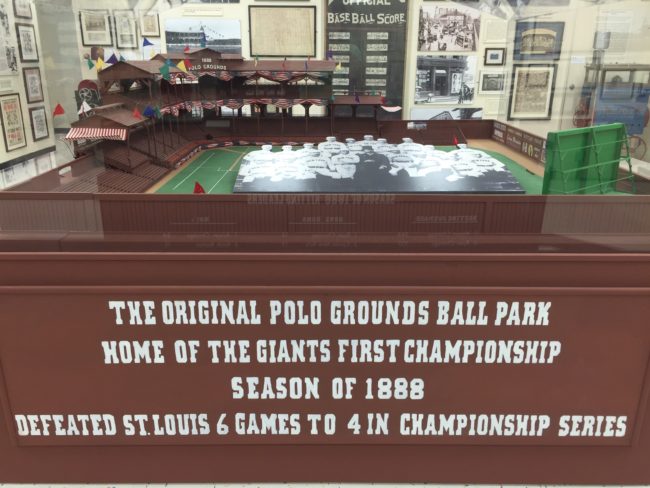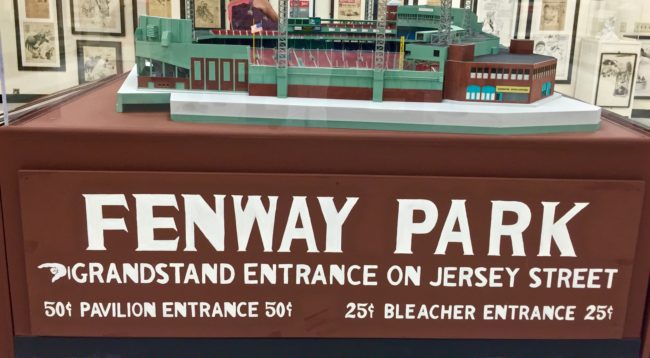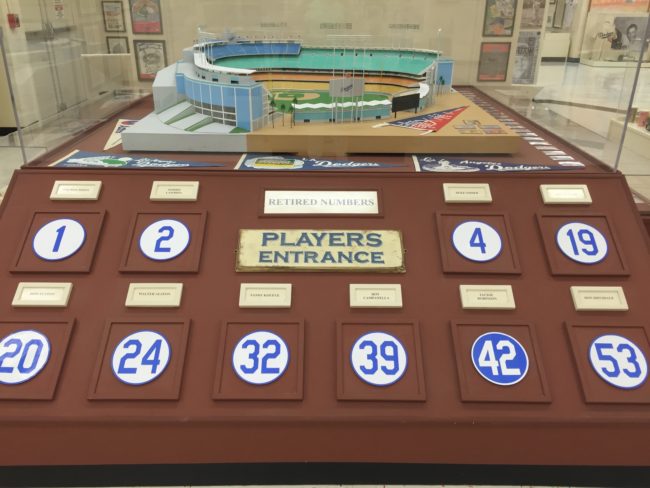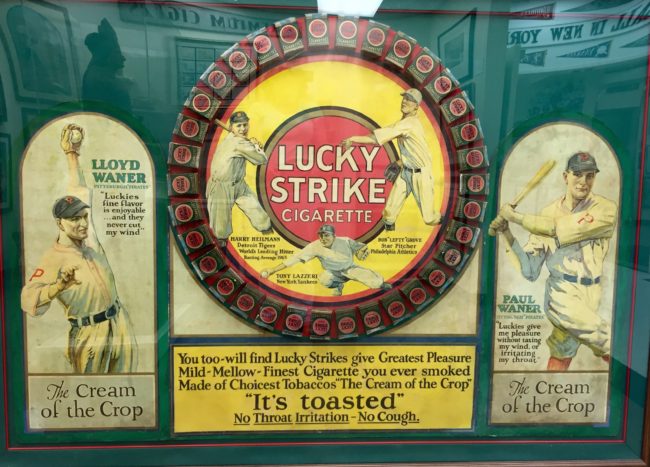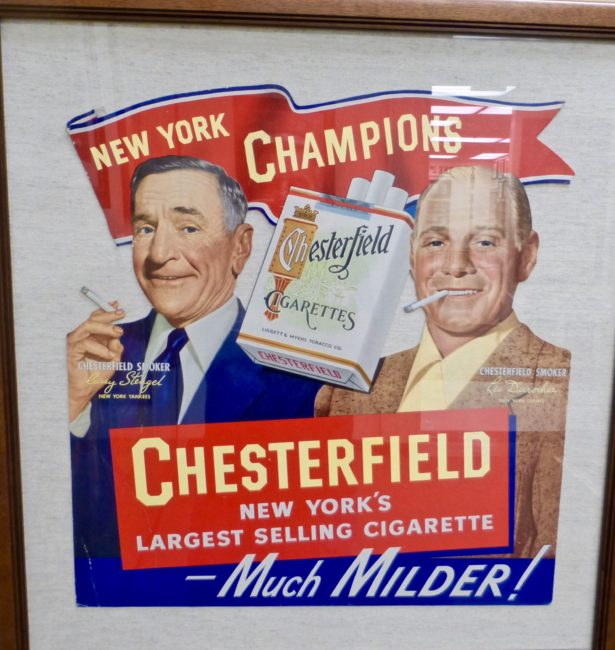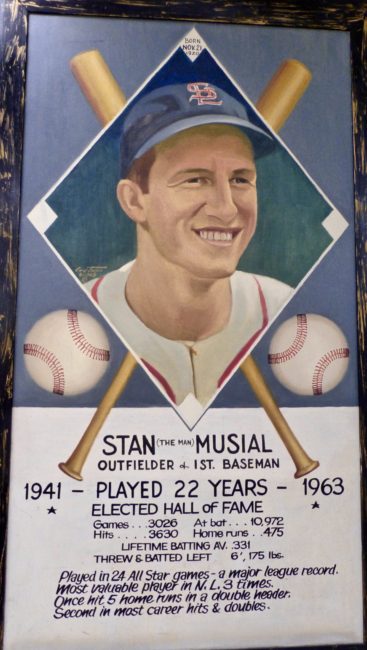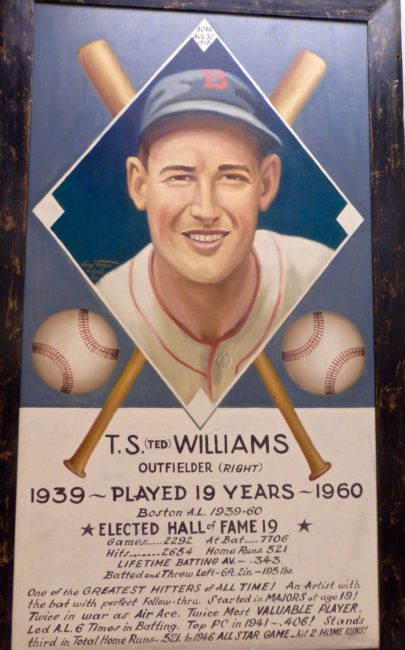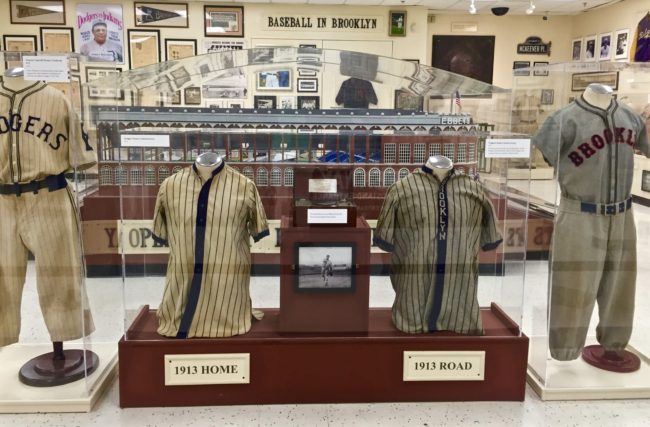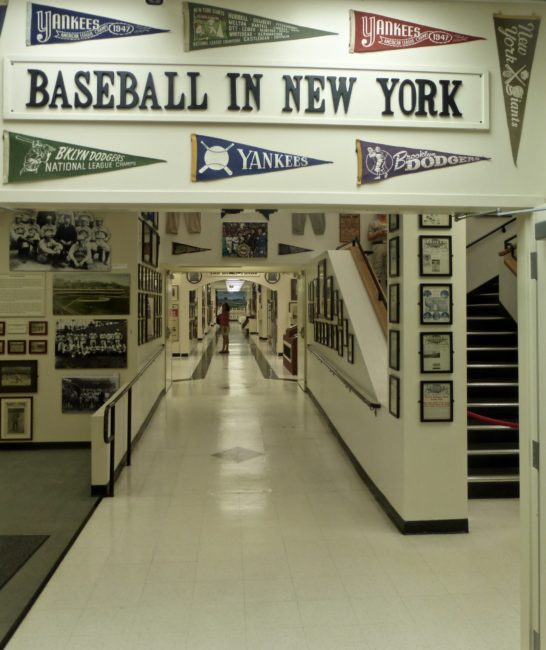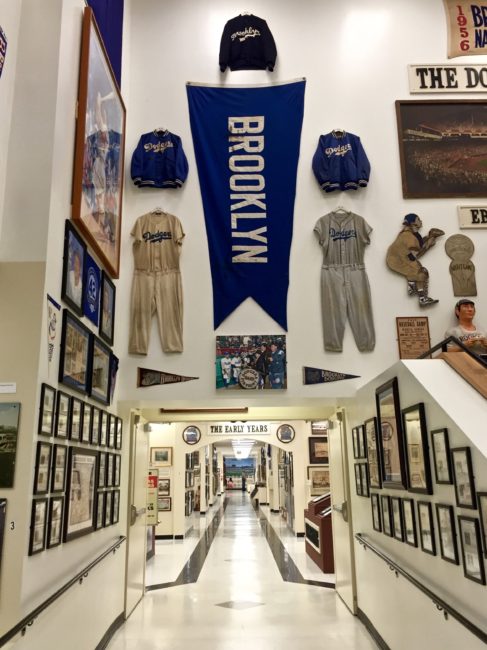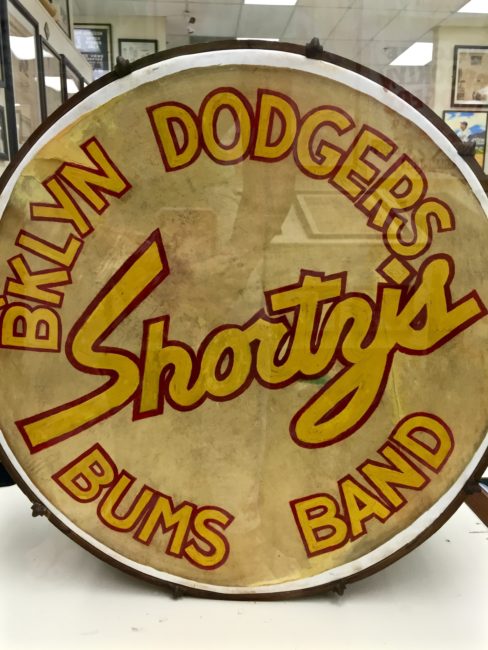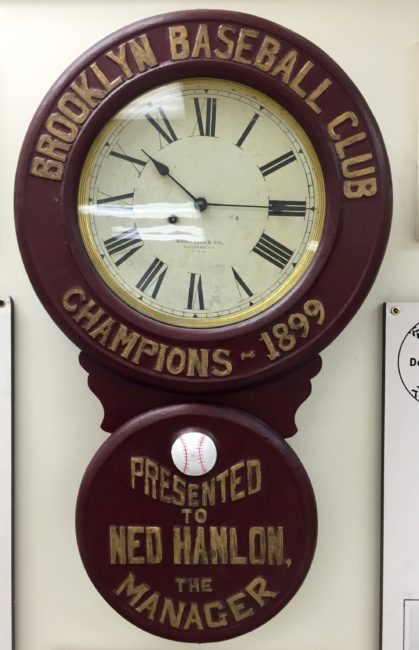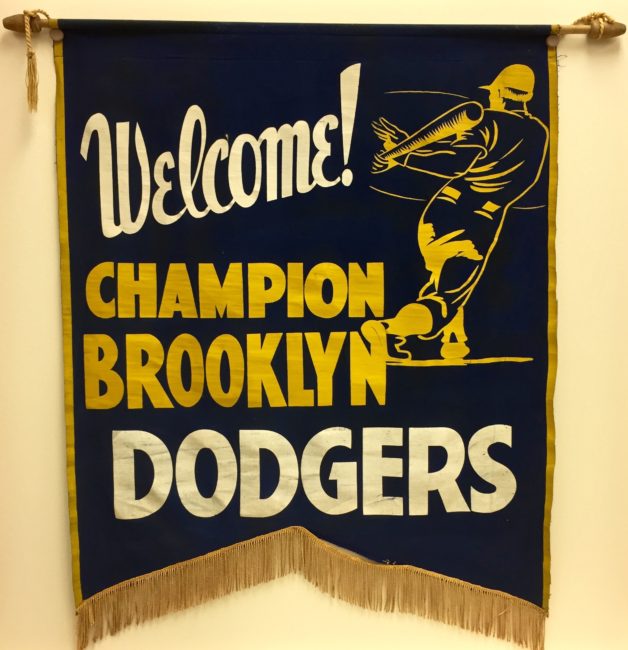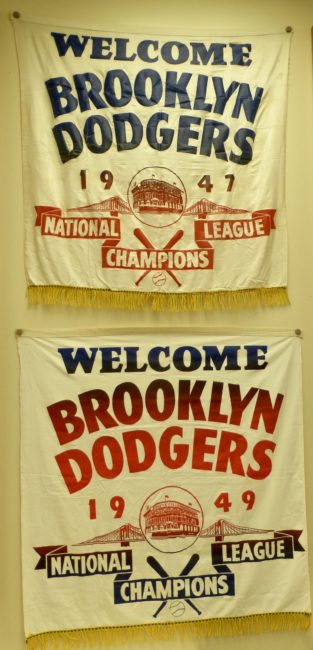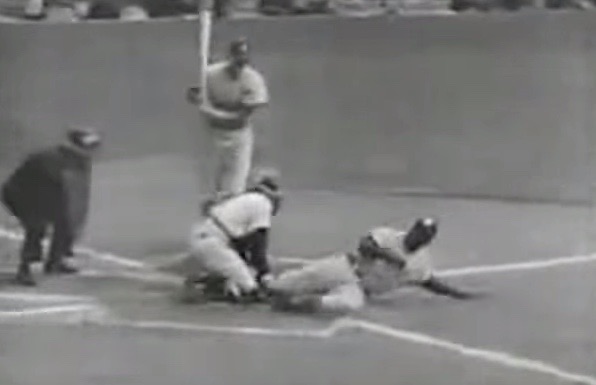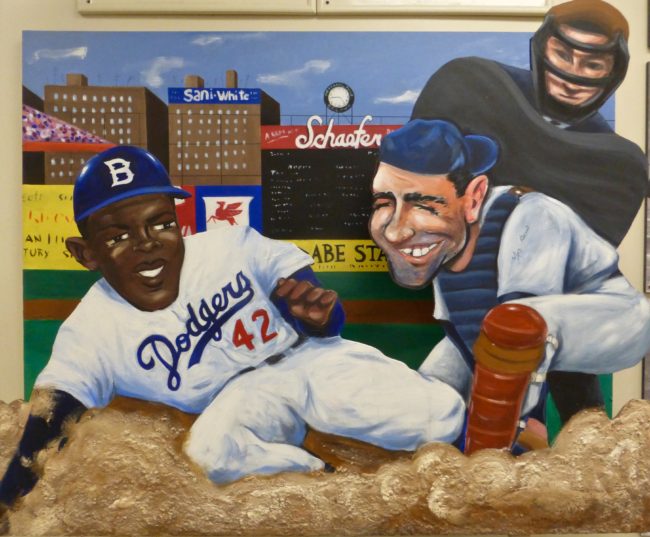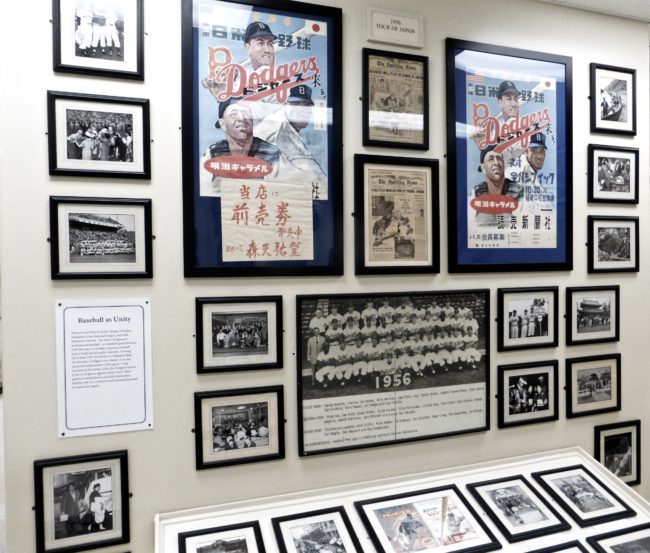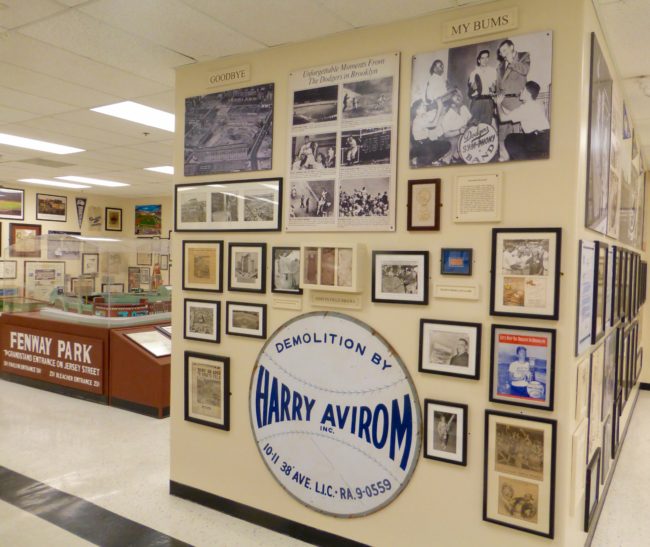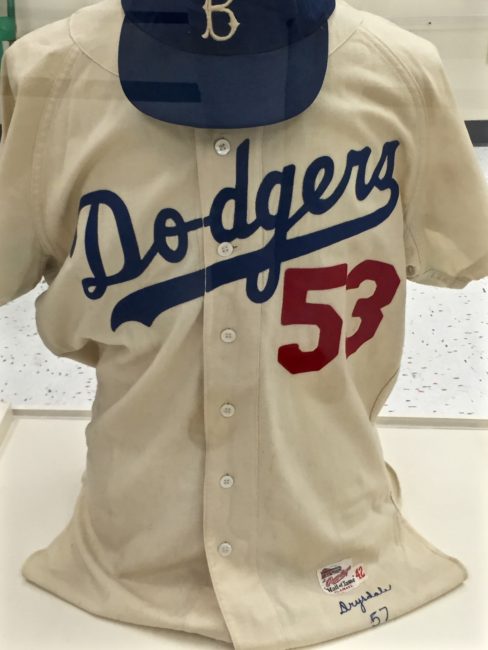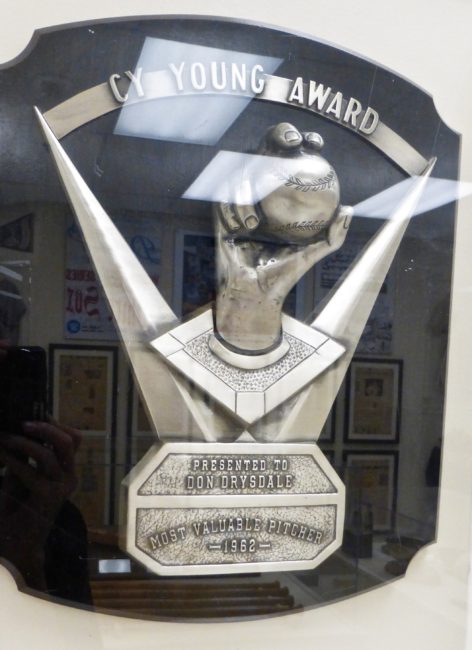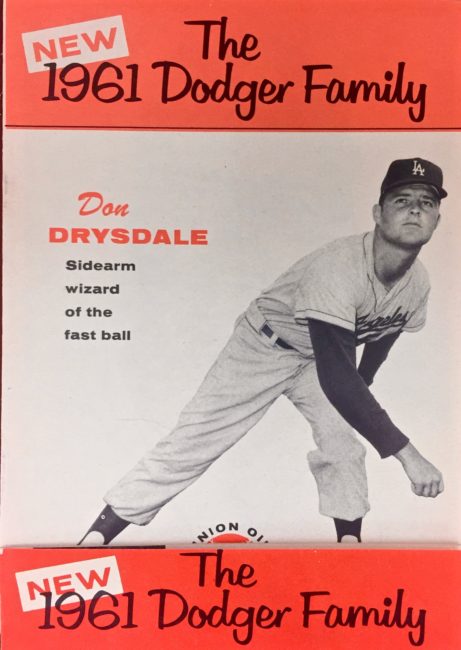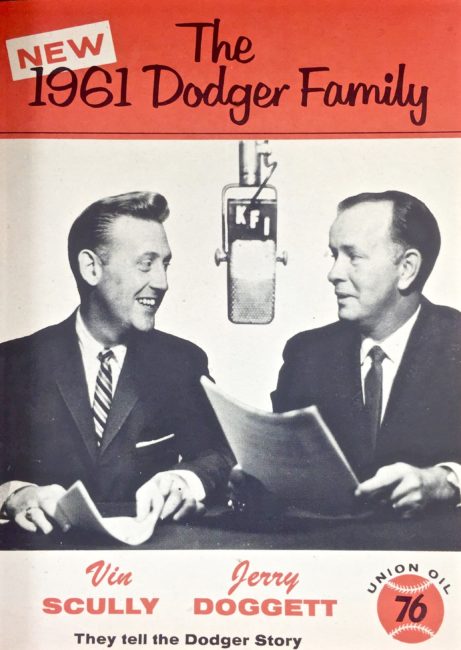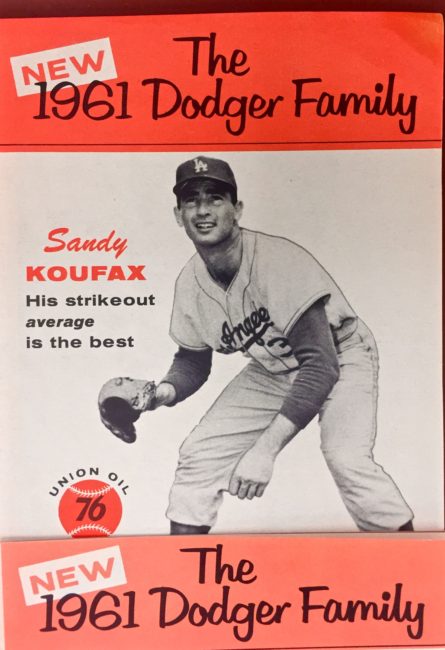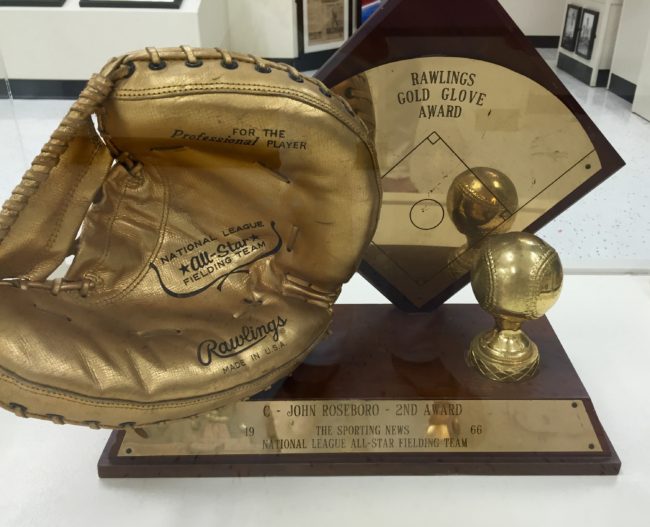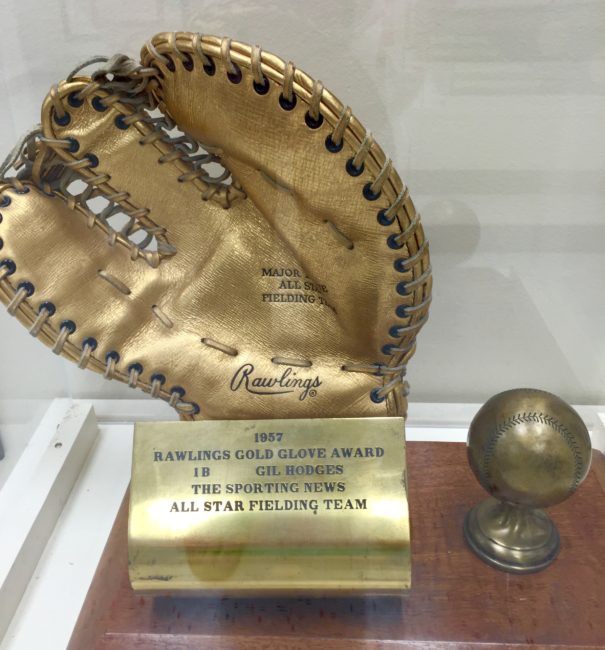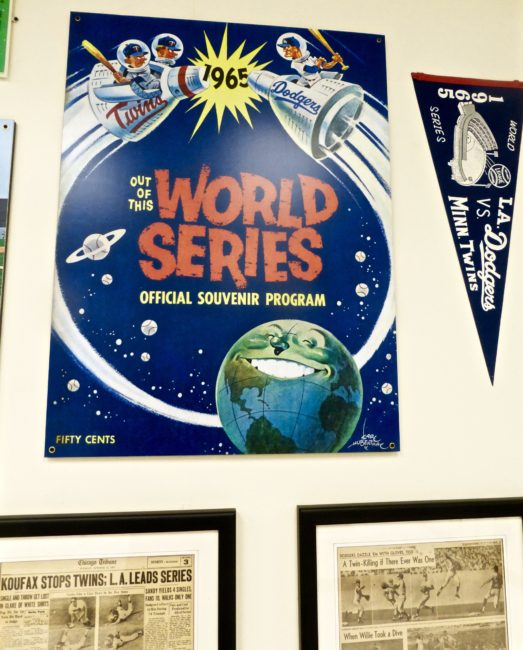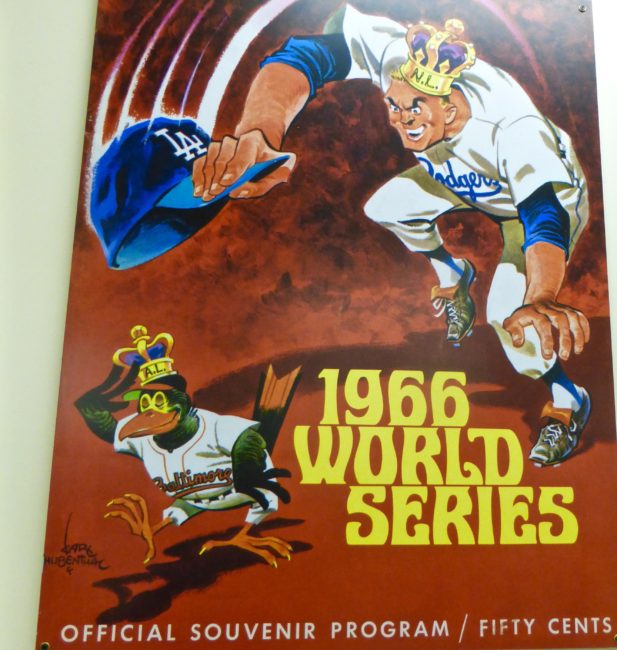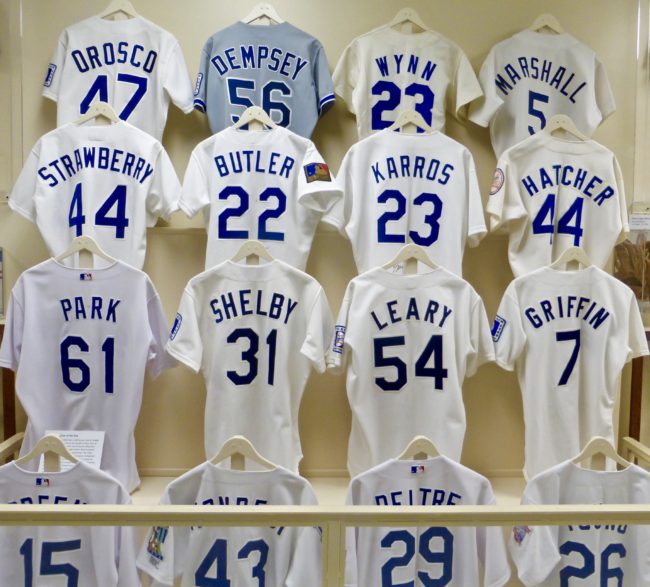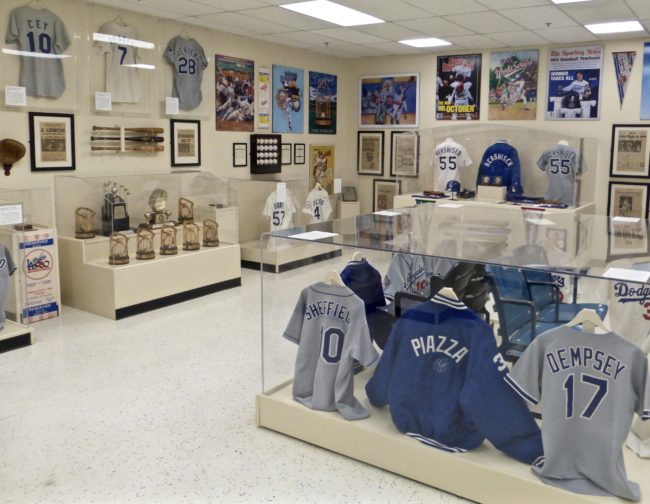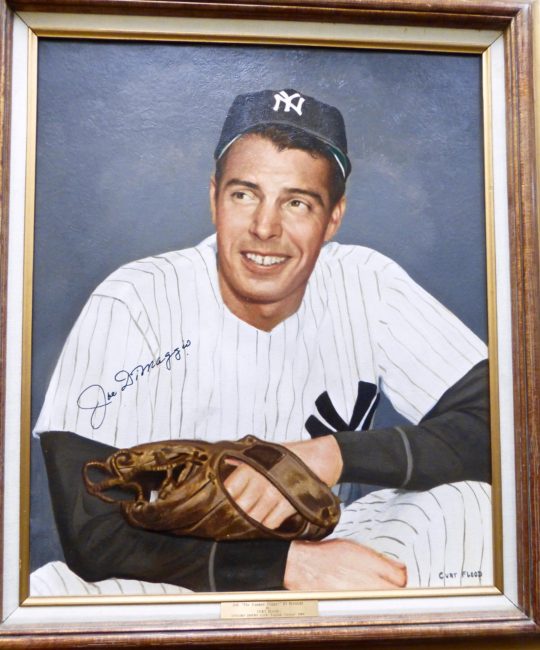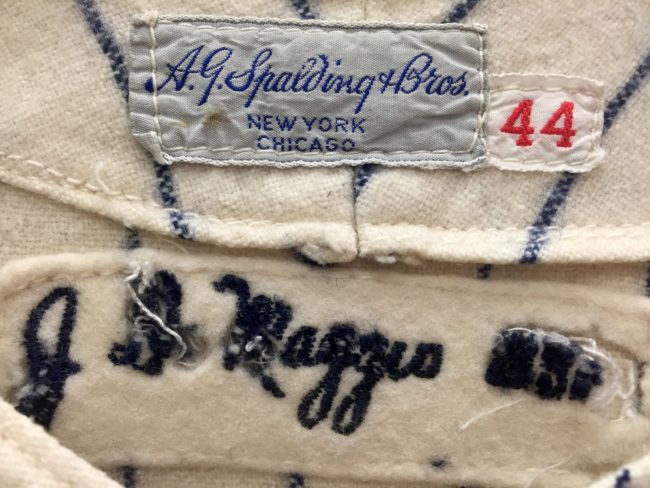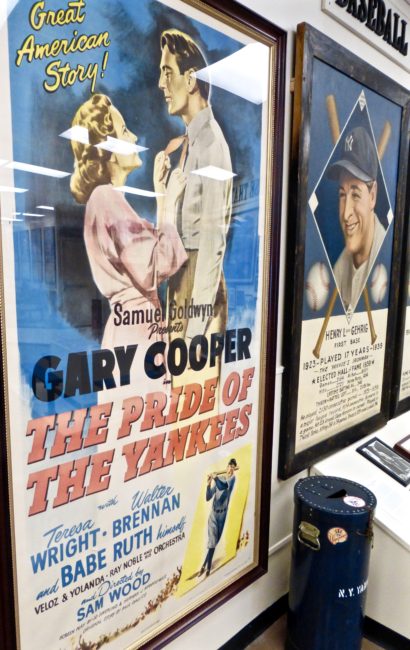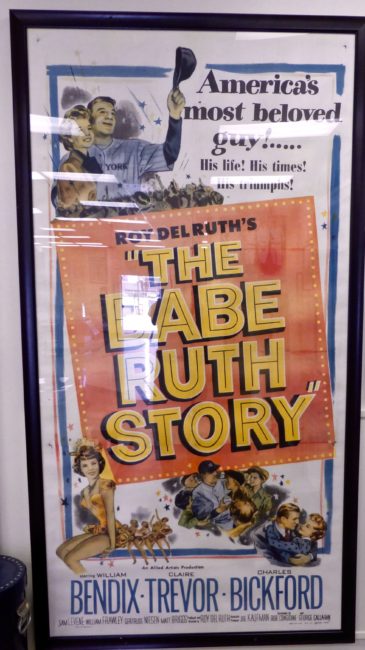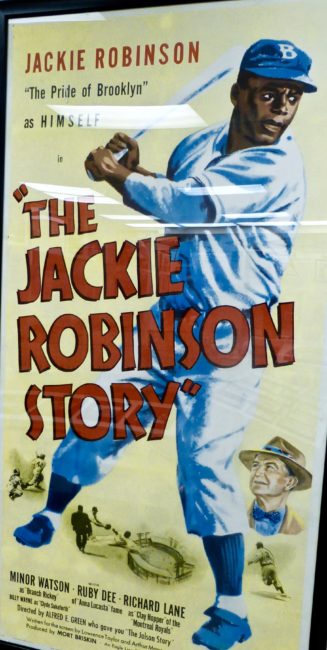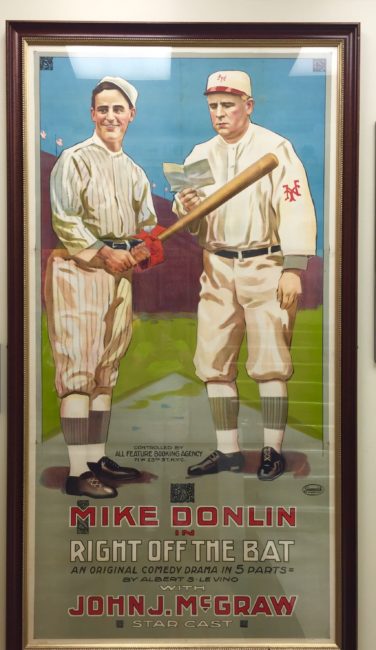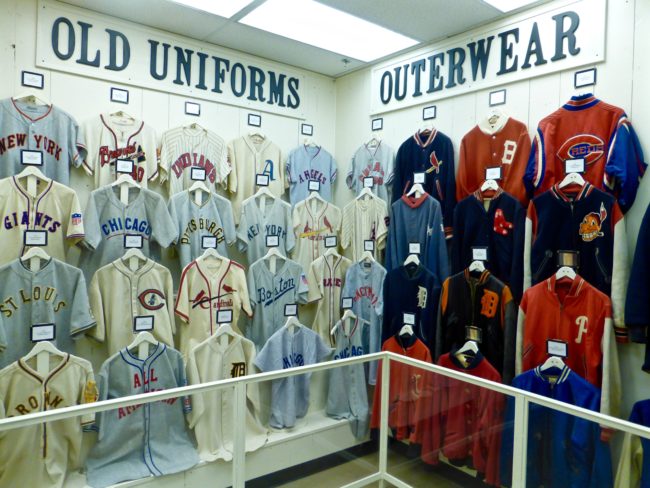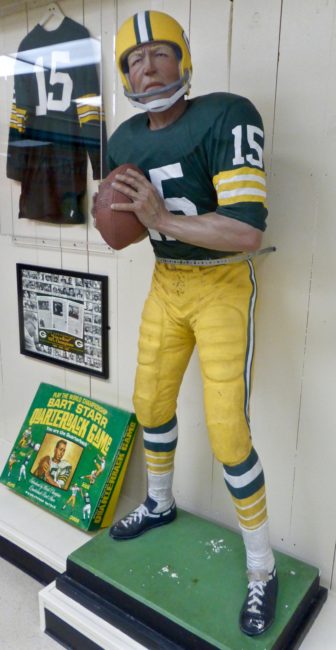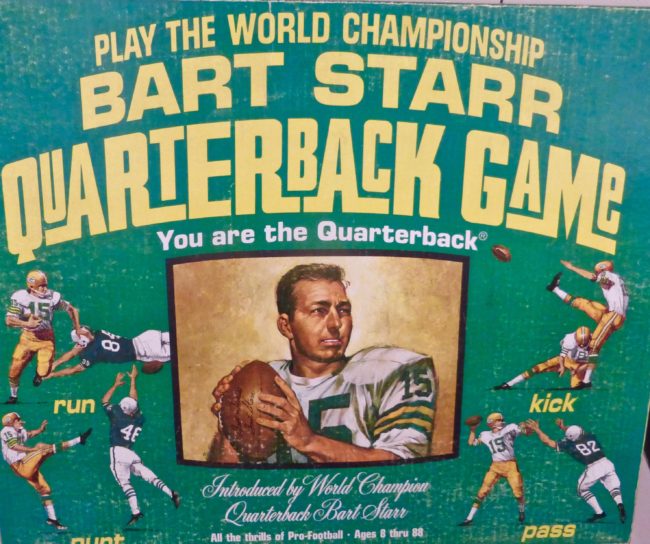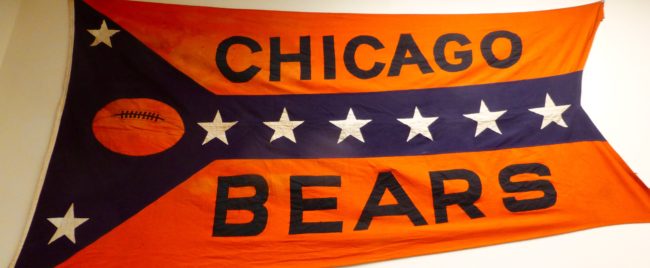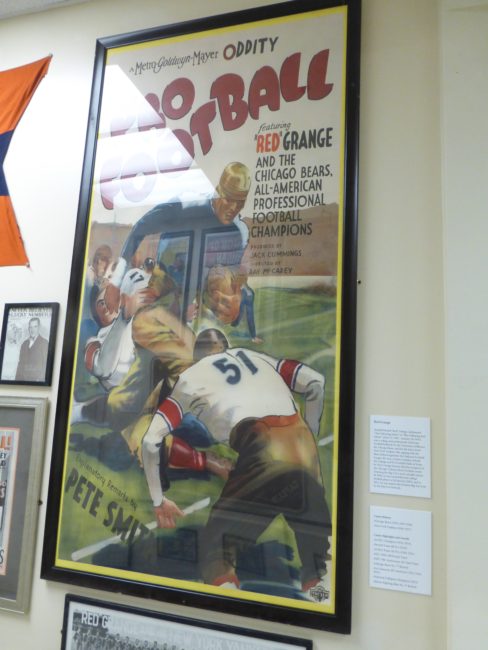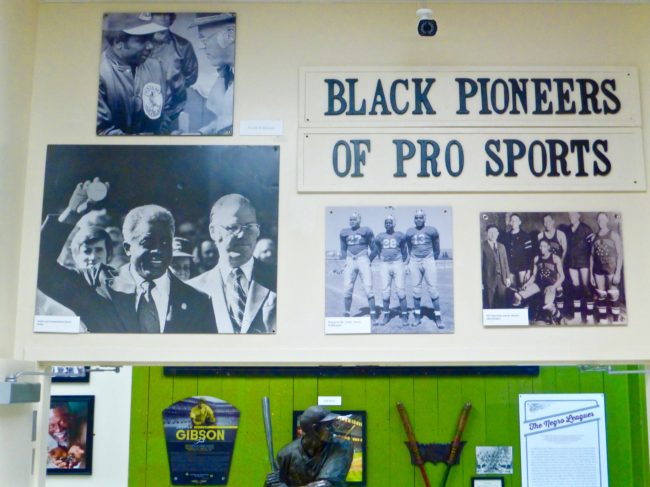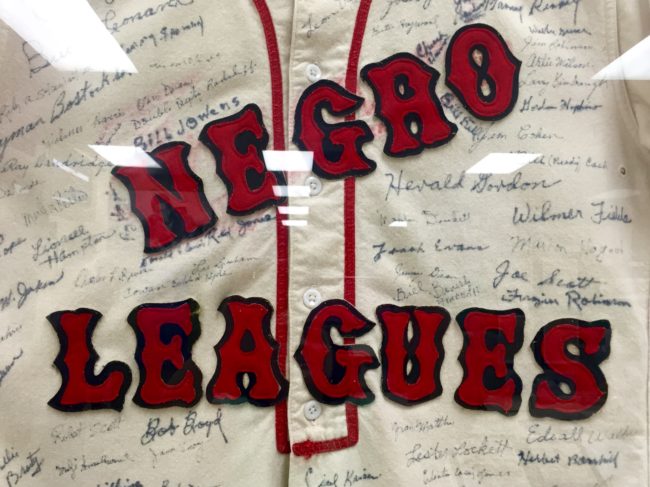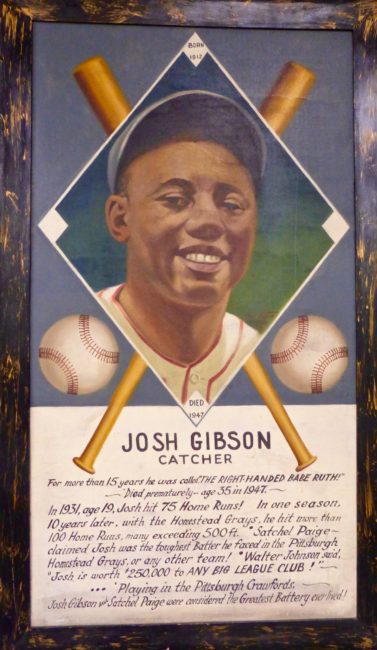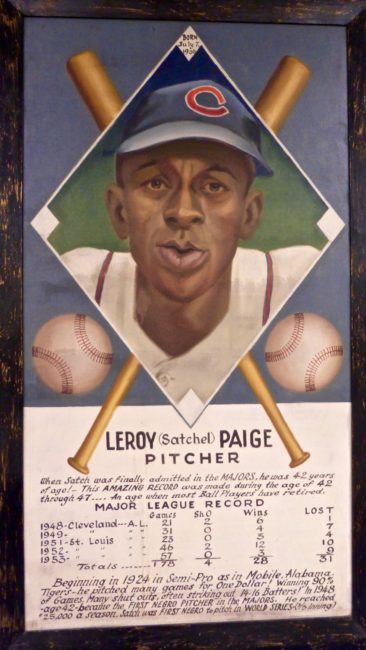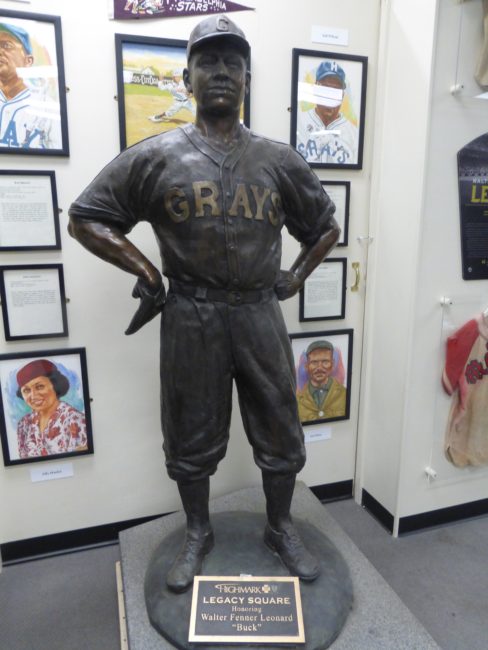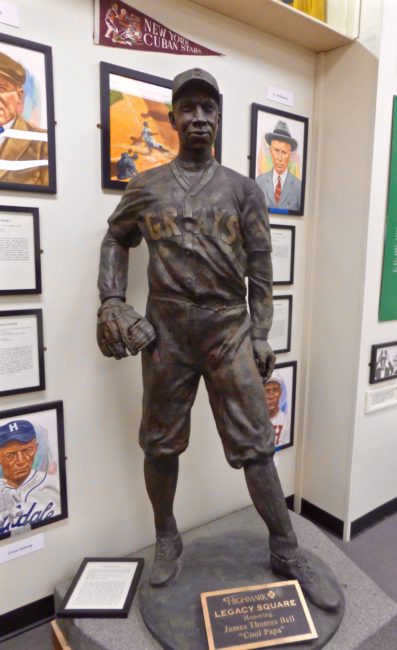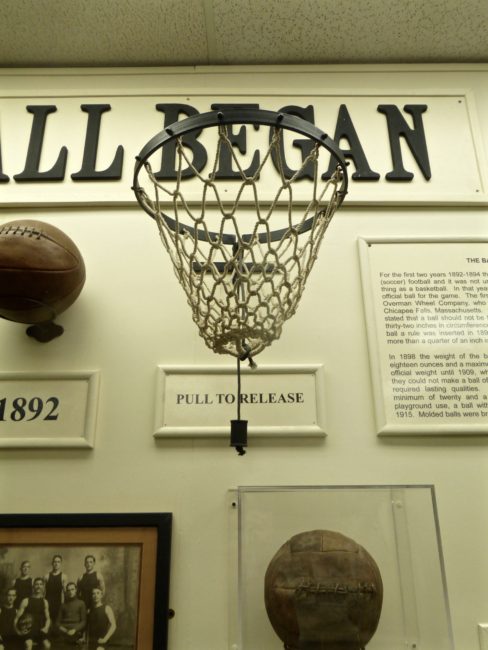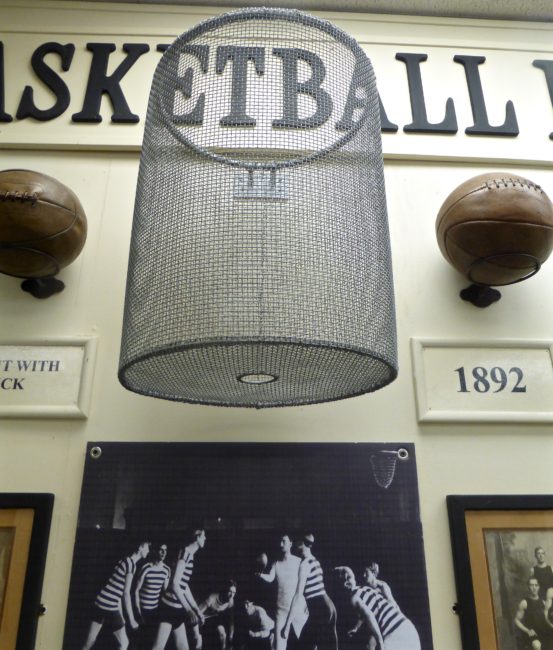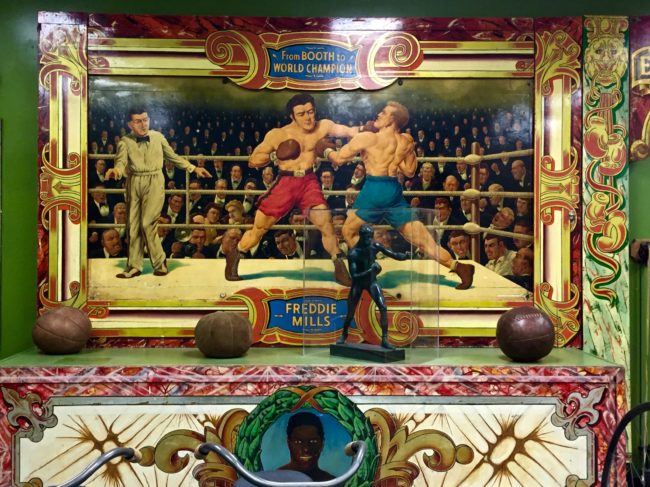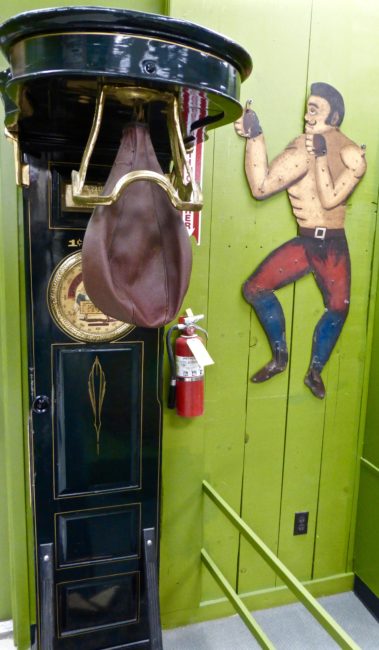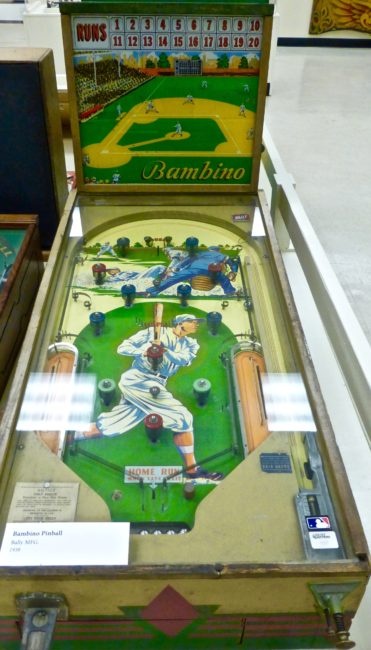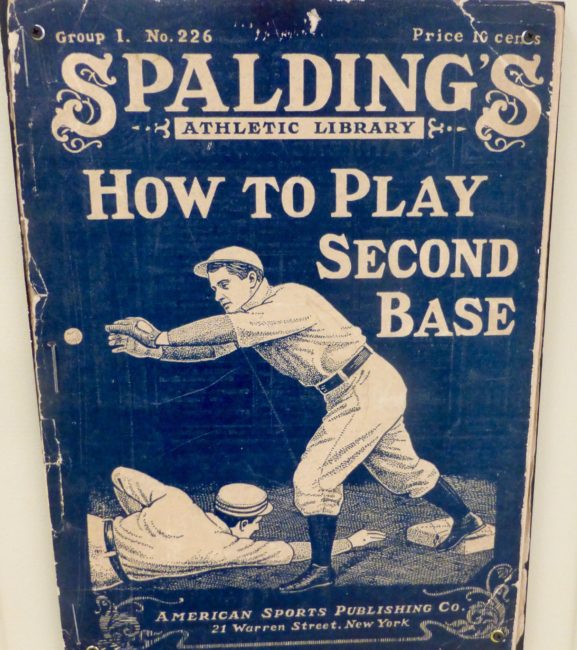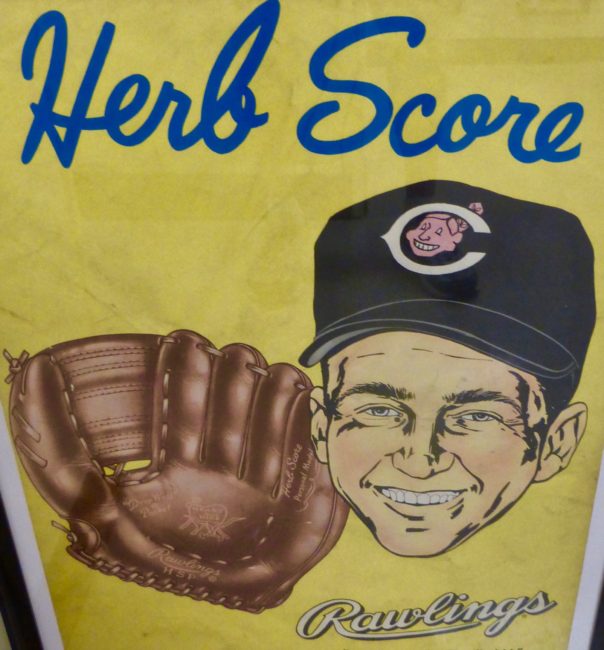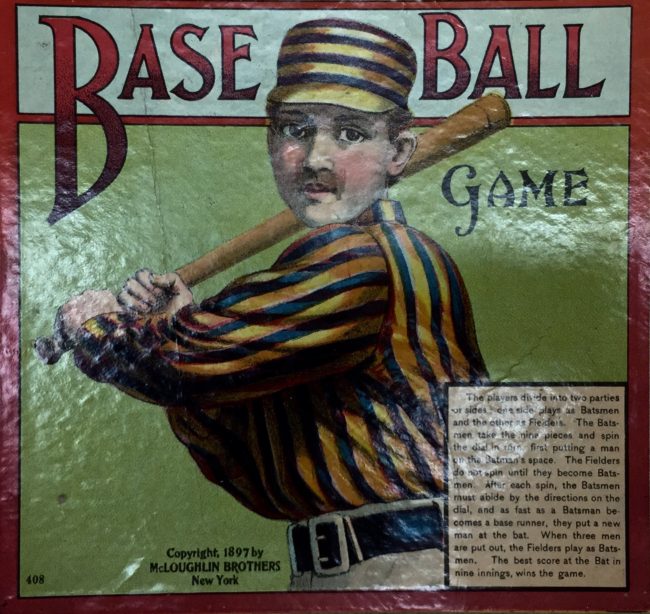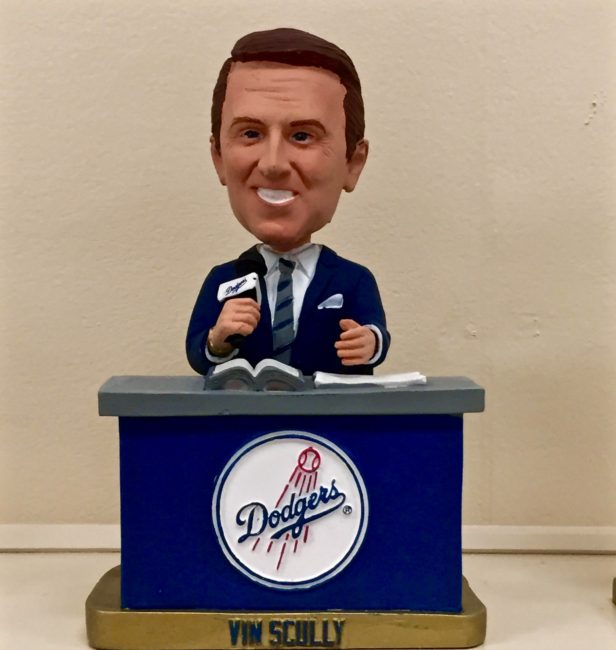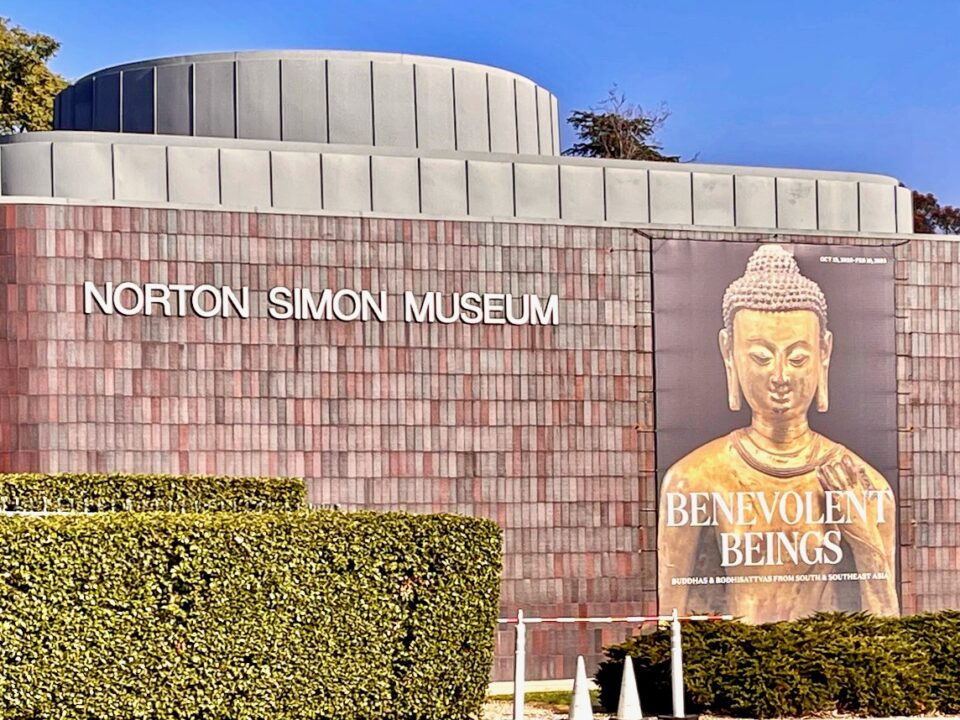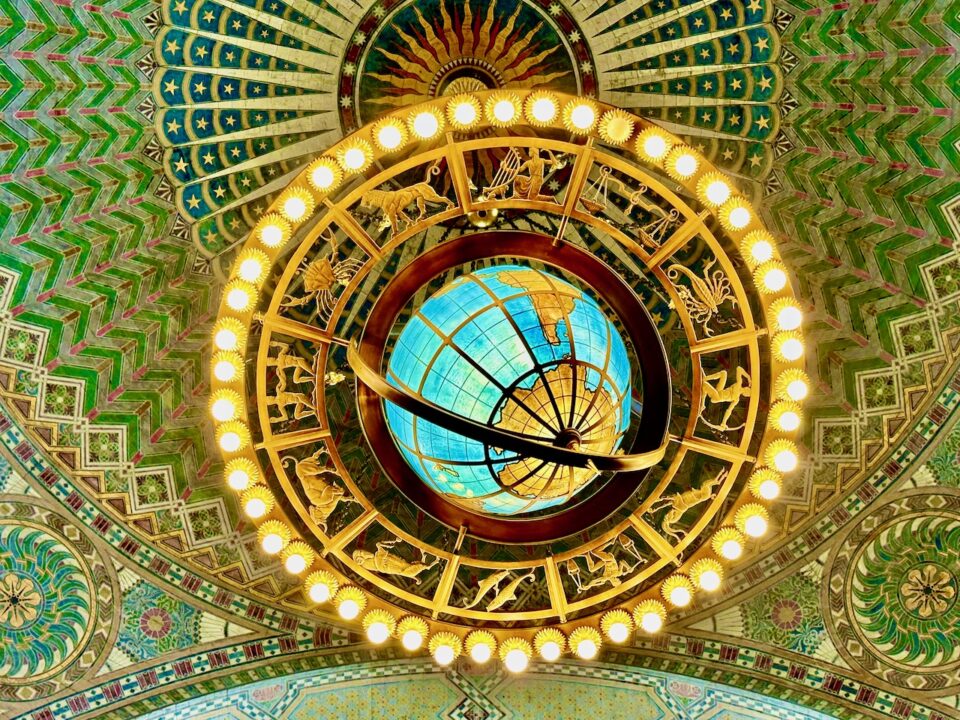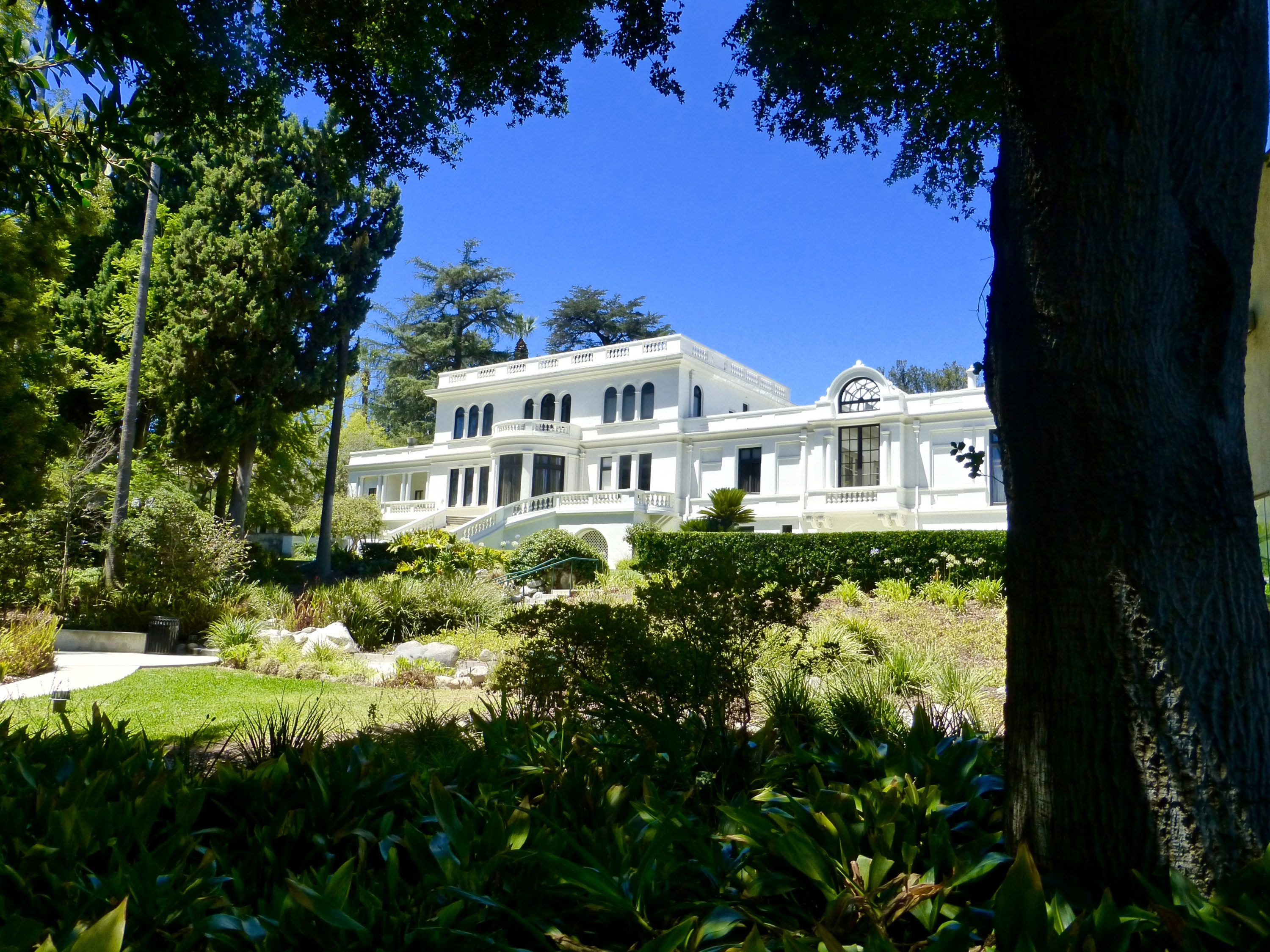
Pasadena Museum of History/Fenyes Mansion – Pasadena
July 28, 2016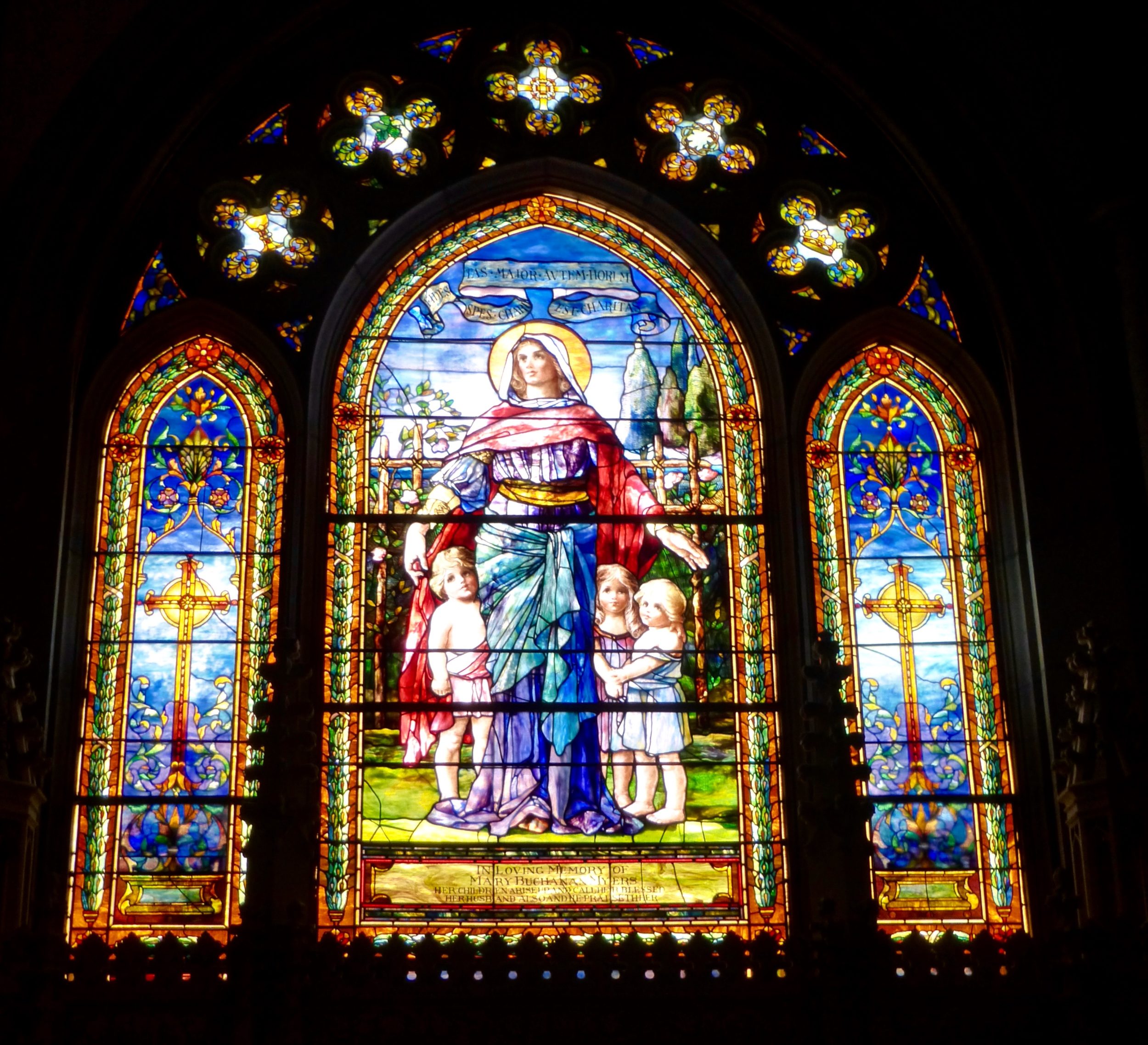
All Saints Episcopal Church – Pasadena
February 17, 2017“Cooperstown West”
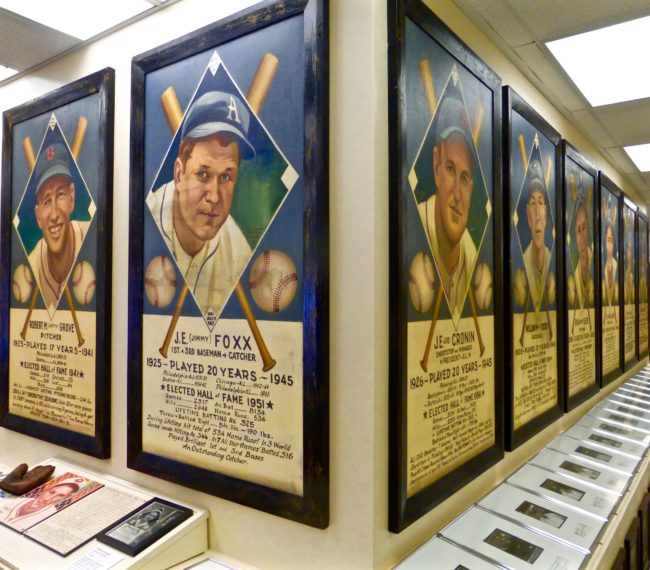 Sports Museum of Los Angeles – Los Angeles
Sports Museum of Los Angeles – Los Angeles
Visited: August 2016
(in October 2016, it was announced that the museum would be closed until they find a new location)
Although it is not officially dubbed “Cooperstown West,” the Sports Museum of Los Angeles could, in reality, use that title and have no qualms in doing so (well, other than the fact Cooperstown might sue them). This is a tremendous sports museum. To me, it was just as memorable, or maybe even more memorable, than my visit to Cooperstown.
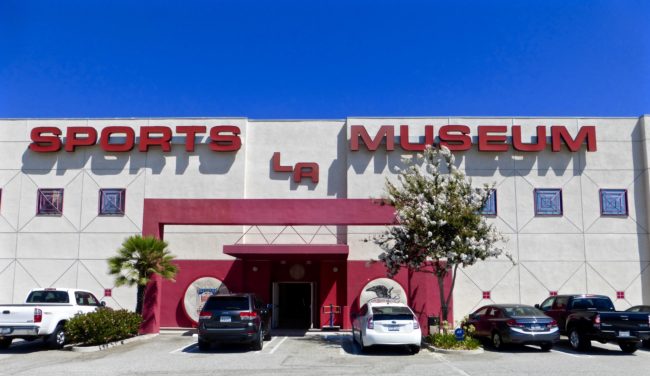 The Sports Museum of Los Angeles contains a treasure trove of historical sports memorabilia that is truly one-of-a-kind. According to former Dodgers’ owner Peter O’Malley, “It’s the best sports museum in the world.” That’s a hard point to argue.
The Sports Museum of Los Angeles contains a treasure trove of historical sports memorabilia that is truly one-of-a-kind. According to former Dodgers’ owner Peter O’Malley, “It’s the best sports museum in the world.” That’s a hard point to argue.
 Located on the corner of Washington Blvd. and Main Street in L.A. in a warehouse district, the museum is the brainchild of former New York resident Gary Cypres, who over the course of three decades collected some 10,000 pieces of memorabilia that are encompassed in this 32,000-foot warehouse (kind of makes my Sports Room at home pale in comparison).
Located on the corner of Washington Blvd. and Main Street in L.A. in a warehouse district, the museum is the brainchild of former New York resident Gary Cypres, who over the course of three decades collected some 10,000 pieces of memorabilia that are encompassed in this 32,000-foot warehouse (kind of makes my Sports Room at home pale in comparison).
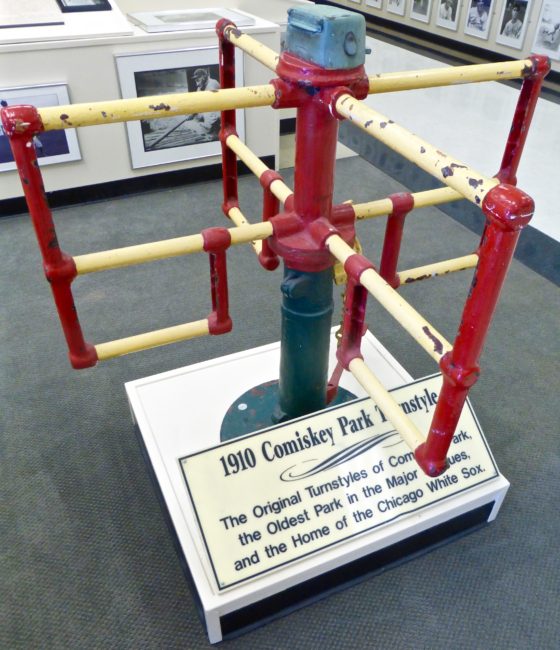 It had been closed for a few years, but recently reopened in mid-July.
It had been closed for a few years, but recently reopened in mid-July.
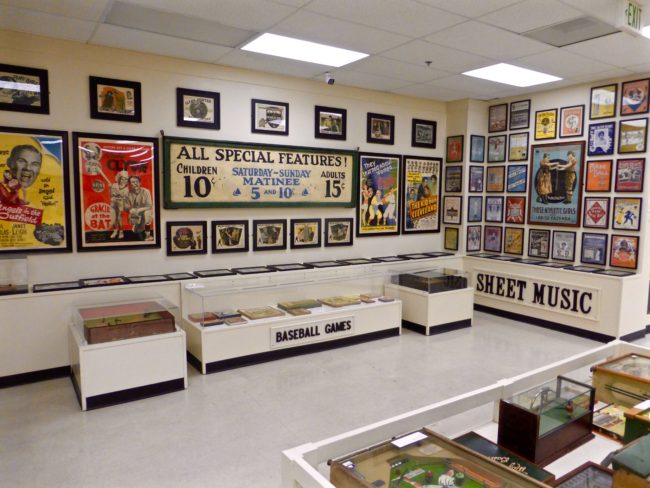 Thirty galleries contain everything from replicas of old ballparks, Gold Gloves, World Series Trophies from 1970 to 2000, the history of the Negro Leagues and historic (and very valuable) baseball trading cards. The card collection includes a Honus Wagner card, which has been dubbed “The Mona Lisa” of trading cards (it’s only a little bit smaller than the painting) to a countless number of other incredible sports artifacts from the 19th through the 21st centuries. Memorabilia from other sports are also on display.
Thirty galleries contain everything from replicas of old ballparks, Gold Gloves, World Series Trophies from 1970 to 2000, the history of the Negro Leagues and historic (and very valuable) baseball trading cards. The card collection includes a Honus Wagner card, which has been dubbed “The Mona Lisa” of trading cards (it’s only a little bit smaller than the painting) to a countless number of other incredible sports artifacts from the 19th through the 21st centuries. Memorabilia from other sports are also on display.
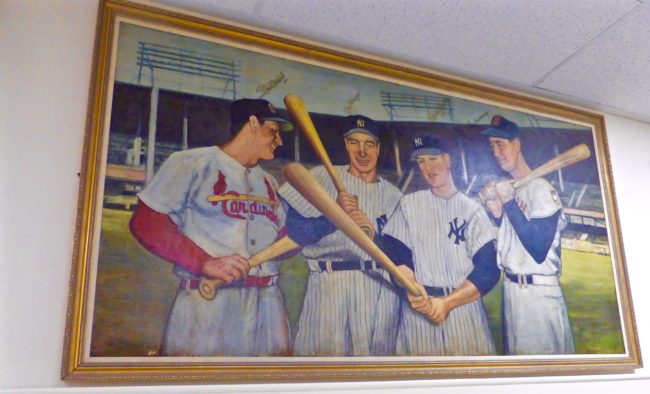
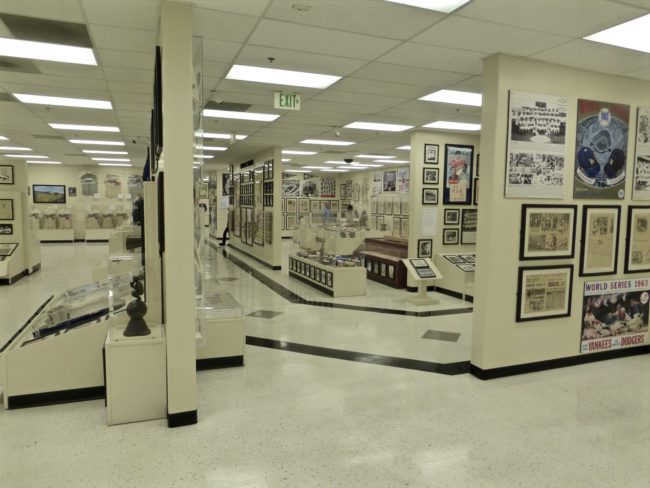 Being from New York, Mr. Cypres accumulated a large number of collectibles from the Brooklyn/Los Angeles Dodgers, New York/San Francisco Giants and New York Yankees. Nearly 20,000 square feet are devoted to the Brooklyn and Los Angeles Dodgers, which was my favorite team until I ruined my sports life and became a Padres’ fan when I attended San Diego State in 1970.
Being from New York, Mr. Cypres accumulated a large number of collectibles from the Brooklyn/Los Angeles Dodgers, New York/San Francisco Giants and New York Yankees. Nearly 20,000 square feet are devoted to the Brooklyn and Los Angeles Dodgers, which was my favorite team until I ruined my sports life and became a Padres’ fan when I attended San Diego State in 1970.
In the understatement of the year, the items I will show you only touch the tip of the iceberg of what is on display in this museum. If you are a sports fan, this place is like being a kid in a candy store. Tracy and I toured the museum for more than two hours recently (it must be a fantastic museum because Tracy, who is not much of a sports’ fan, thinks Ty Cobb is a new corn variety. She’s spending too much time in Tracy’s Kitchen).
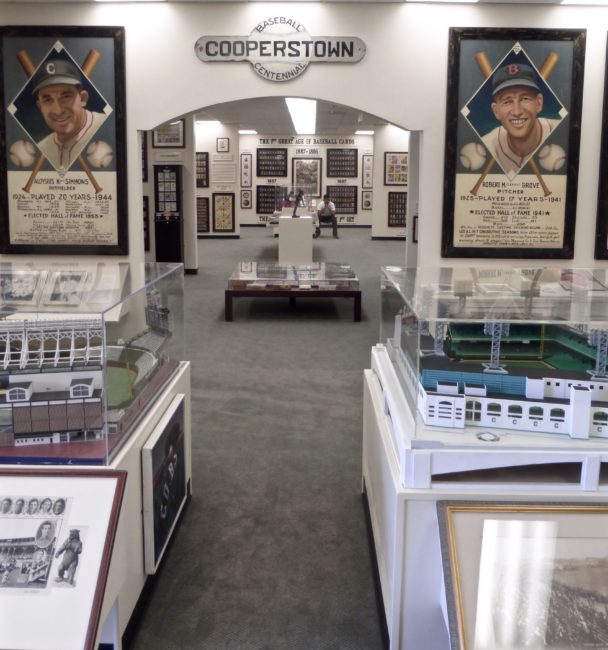 Walking into the museum (I’ll try to go in some semblance of order of what we saw…we meandered a lot), the first thing you will notice are large paintings of famous baseball players that adorn the walls. It makes sense because some of these players were indeed larger than life.
Walking into the museum (I’ll try to go in some semblance of order of what we saw…we meandered a lot), the first thing you will notice are large paintings of famous baseball players that adorn the walls. It makes sense because some of these players were indeed larger than life.
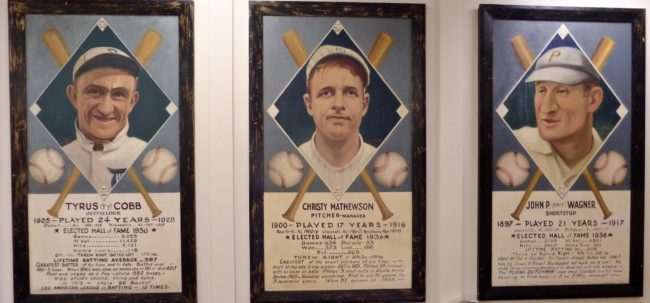 In 1963, former Detroit Tigers second baseman Tony Piet commissioned Carl Tolpo to create these paintings to decorate Piet’s Detroit Pontiac dealership. It was called “The Gallery of Greats.”
In 1963, former Detroit Tigers second baseman Tony Piet commissioned Carl Tolpo to create these paintings to decorate Piet’s Detroit Pontiac dealership. It was called “The Gallery of Greats.”
Besides being beautiful, these paintings incorporate interesting facts about each player.
Moving on, I suddenly became angry with my sister who threw out my baseball card collection when I was a kid (I could have retired at 40 with some of those cards I had collected). In these rooms, we looked at cards throughout the decades,
including that famed Honus Wagner card. His cards virtually disappeared, so a Wagner card today is quite valuable (one card sold for $2.8 million).
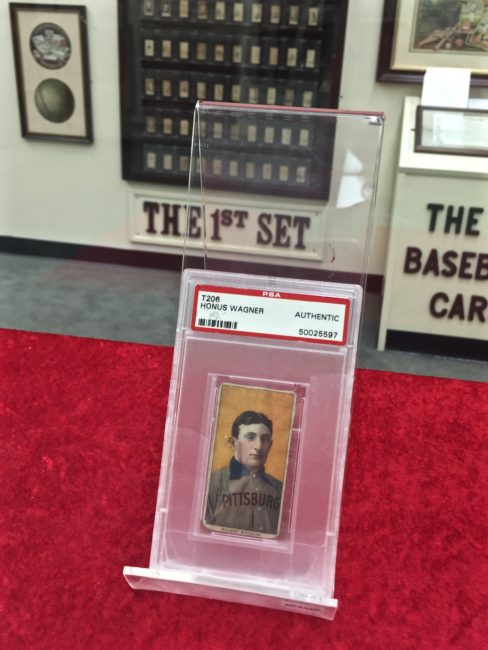 As we walked through the museum, periodically we would come upon replicas of historic ballparks: from Wrigley Field and the Polo Grounds…
As we walked through the museum, periodically we would come upon replicas of historic ballparks: from Wrigley Field and the Polo Grounds…
…to Fenway Park and Dodger Stadium (sadly, no Dodger Dogs). Somehow I missed Ebbets Field. I hope it didn’t get demolished.
We took a swing at viewing some Hall of Fame Bats. Fortunately, Juan Marichal was nowhere in sight, although we will check in with Johnny Roseboro shortly.
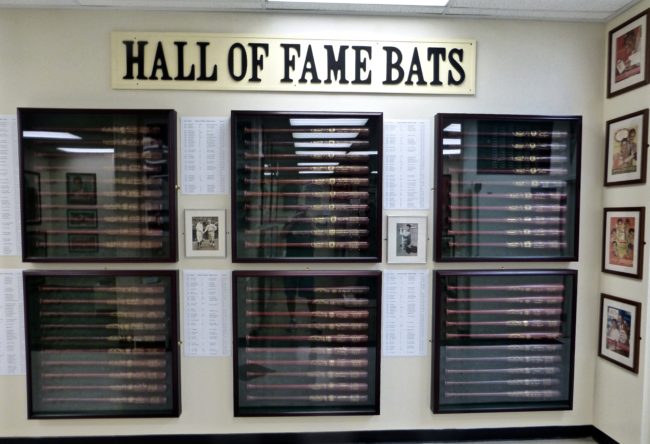 There’s a room dedicated to old ads featuring players, managers and movie stars (pardon the glare on some of the photos…no way around that).
There’s a room dedicated to old ads featuring players, managers and movie stars (pardon the glare on some of the photos…no way around that).
It seemed that to be a good player in the old days meant to light up a cigarette.
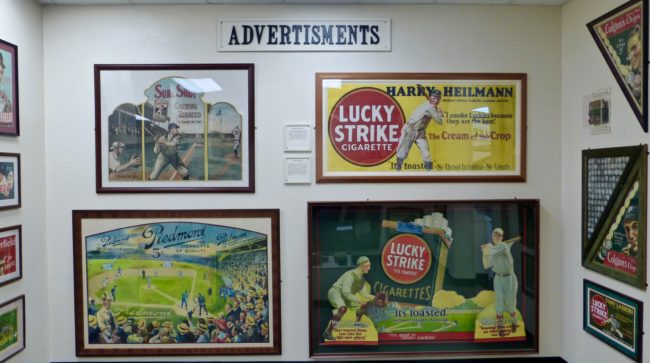 Perhaps that’s why the Bambino huffed and puffed around the bases. Oh that William Bendix, always living the “Life of Riley.”
Perhaps that’s why the Bambino huffed and puffed around the bases. Oh that William Bendix, always living the “Life of Riley.”
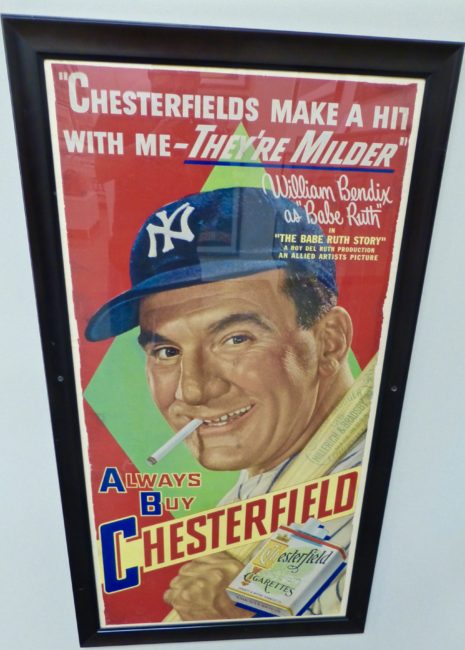 We paid our respects to “Stan the Man” and “The Splendid Splinter” and moved on.
We paid our respects to “Stan the Man” and “The Splendid Splinter” and moved on.
An interesting painting beckoned us. Otto Boetticher was a New York commercial artist who was captured by the Confederate Army in 1862. He painted Union soldiers playing baseball at a Confederate prison camp. This was the first time southerners had been indoctrinated to baseball, and it actually “helped spread the game to all parts of the country after the war.”
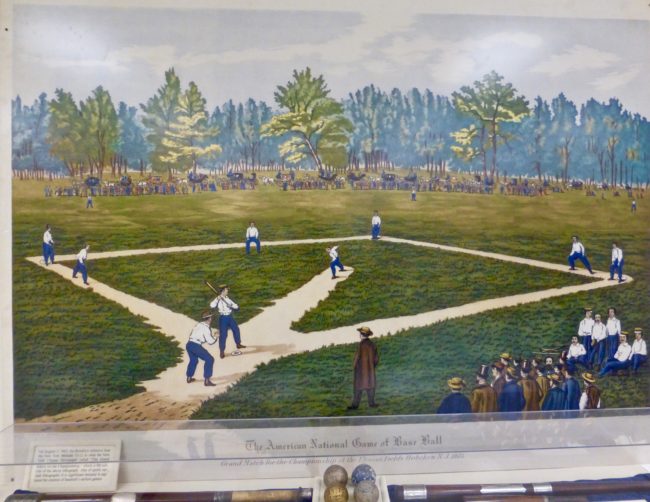 It was now time to go to New York.
It was now time to go to New York.
There were tons of Brooklyn Dodger memorabilia to wade through.
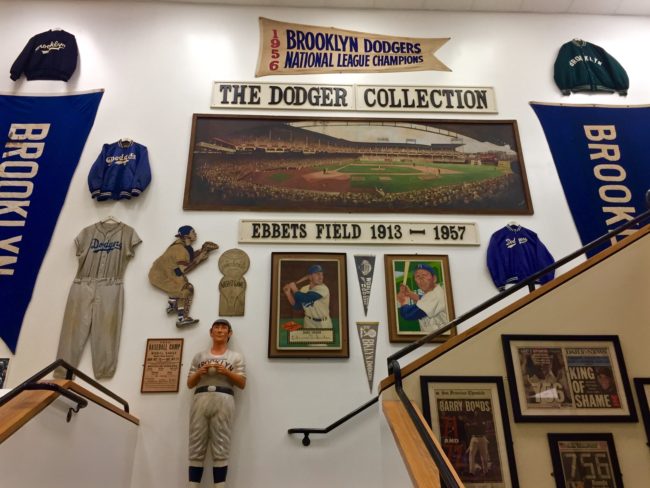 Truthfully, if you wanted to see everything on display here in one visit; you couldn’t, which is why I’m already planning my return.
Truthfully, if you wanted to see everything on display here in one visit; you couldn’t, which is why I’m already planning my return.
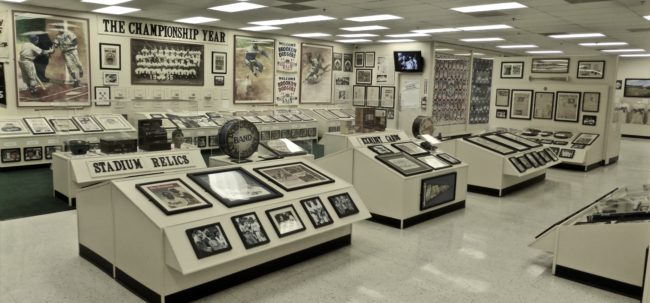 Among many items, we found at an instrument drummed up by some Brooklyn fans, and a Brooklyn Baseball clock commemorating the 1899 championship. I can just hear them saying, “Well, it’s about time!”
Among many items, we found at an instrument drummed up by some Brooklyn fans, and a Brooklyn Baseball clock commemorating the 1899 championship. I can just hear them saying, “Well, it’s about time!”
Some banners were hanging around.
…and a pennant of Pasadena’s finest, Jackie Robinson, and his All-Stars; a team comprised of African American players who conducted some barnstorming tours during the postseason.
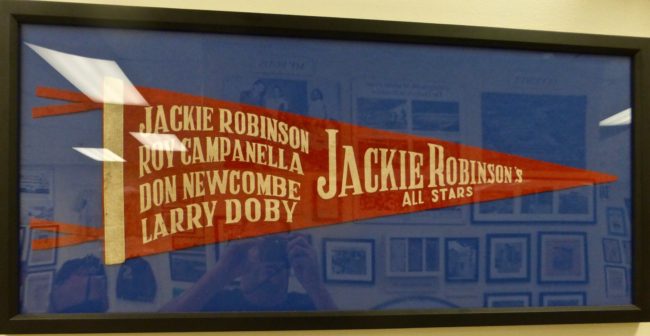 In one of the rooms a video played of Jackie’s stealing home in the 1955 World Series, and the Yankees’ Yogi Berra going berserk about the call of “safe.” There was also a cool mural depicting the event.
In one of the rooms a video played of Jackie’s stealing home in the 1955 World Series, and the Yankees’ Yogi Berra going berserk about the call of “safe.” There was also a cool mural depicting the event.
I also watched the fantastic catch by Sandy Amorós in the ’55 Series, which helped catapult the Dodgers to their first World Championship.
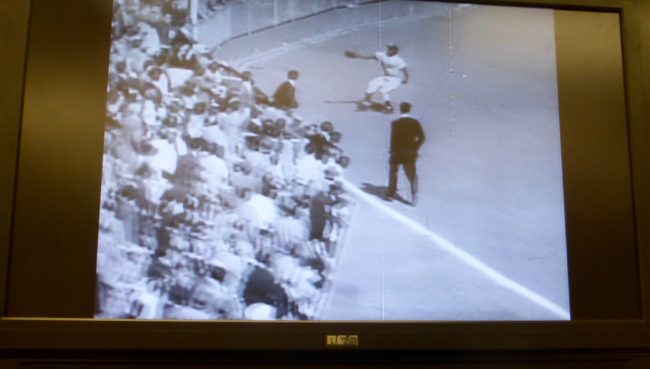 Then Tracy and I bid adieu to Brooklyn.
Then Tracy and I bid adieu to Brooklyn.
It was time to travel west to Los Angeles. The 1959 Dodgers are my first recollection of watching and listening to baseball. I’ll never forget Vin Scully’s call in the playoff with the Milwaukee Braves at the Coliseum: “Big bouncer over the mound, over second base, up with it is Mantilla, throws low and wild! Hodges scores! We go to Chicago!” It was then, at the ripe old age of seven, that I became a full-fledged baseball junkie.
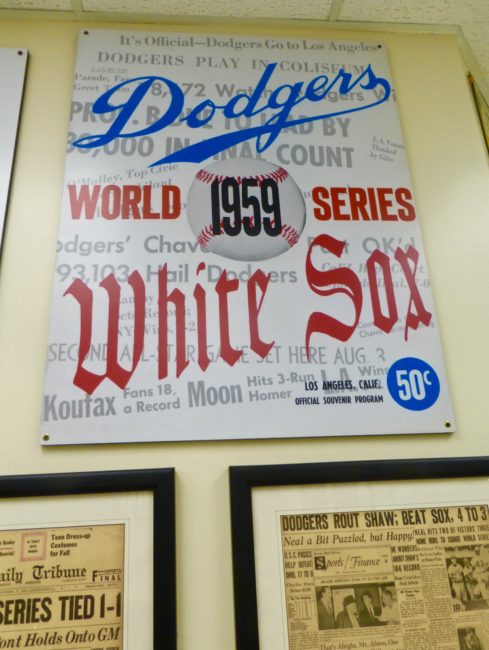 Watching highlights from the 1959 World Series against the ‘Go-Go’ White Sox brought back fond memories…
Watching highlights from the 1959 World Series against the ‘Go-Go’ White Sox brought back fond memories…
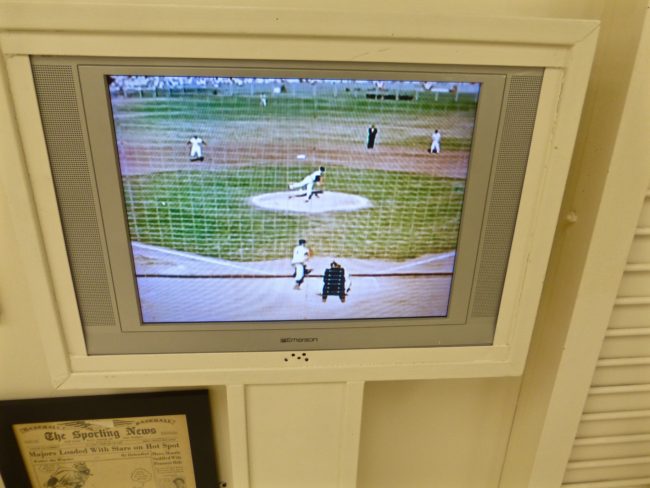 …and looking at the surrounding articles and photos was pretty cool.
…and looking at the surrounding articles and photos was pretty cool.
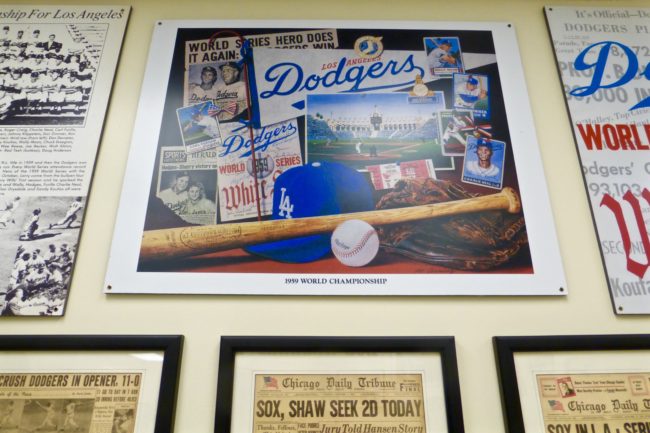 Although Sandy Koufax was my favorite Dodger, I also loved Don Drysdale. There were lots of Drysdale memories here, including his Cy Young Award from 1962.
Although Sandy Koufax was my favorite Dodger, I also loved Don Drysdale. There were lots of Drysdale memories here, including his Cy Young Award from 1962.
…and pieces that celebrated his record-breaking scoreless inning streak (eventually broken by another Dodger Orel Hershiser in a game that Drysdale announced).
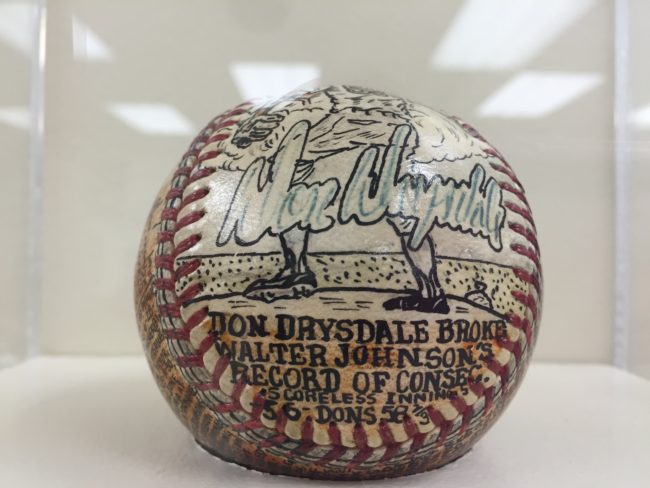 By the way, Hershiser said of the Sports Museum of Los Angeles, “I’ve never seen anything like it. It’s spectacular. Anyone who loves the Dodgers needs to see it. There’s so much to take in. I can’t wait to go back.”
By the way, Hershiser said of the Sports Museum of Los Angeles, “I’ve never seen anything like it. It’s spectacular. Anyone who loves the Dodgers needs to see it. There’s so much to take in. I can’t wait to go back.”
When I was a kid, I made my family purchase their gas at Union 76 (“You always get the finest, the very best, the finest, at the sign of the ’76”). Why? They always gave out fun Dodger collectibles. I still have many Dodger tumblers and Dodger prints in my Sports Room (yes, Tracy indulges me). The museum contains many of these and other pieces that the Union stations handed out.
I loved listening to those Dodger 45s my dad would pick up for me while getting gas at 19 cents a gallon. “Go, Maury, Go!”
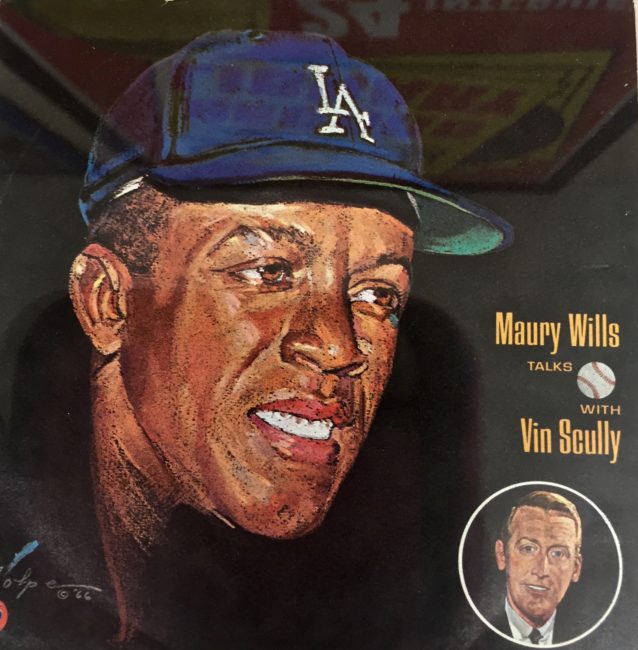 How about gold gloves from catcher John Roseboro and first baseman Gil Hodges? They’re on display here!
How about gold gloves from catcher John Roseboro and first baseman Gil Hodges? They’re on display here!
I’m lucky enough to have numerous Dodger World Series Programs in my collection, and the museum included these large size replicas of some of them.
The Dodgers swept the damned Yankees (we’ll see them shortly) in 1963, and they didn’t even need “Shoeless” Joe Hardy.
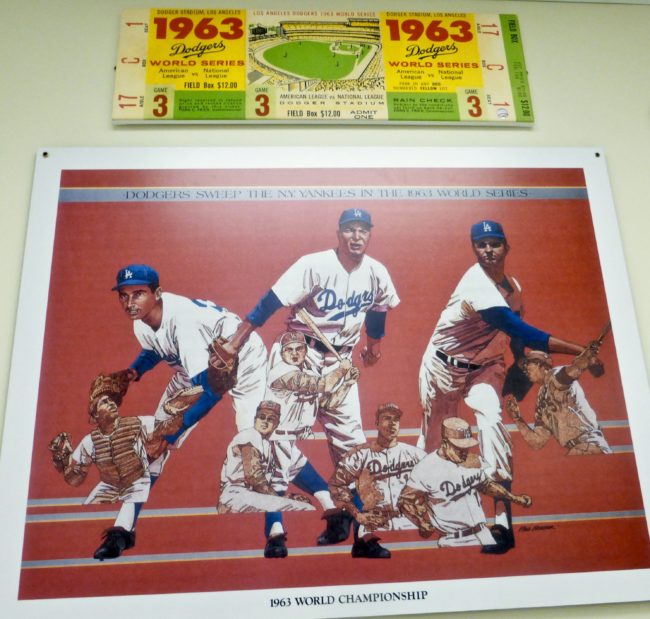 Among the hundreds of pieces in this collection, there were assorted jerseys worn by Dodger players through the years and…
Among the hundreds of pieces in this collection, there were assorted jerseys worn by Dodger players through the years and…
…a painting that might want to be avoided by any fan of the Oakland A’s.
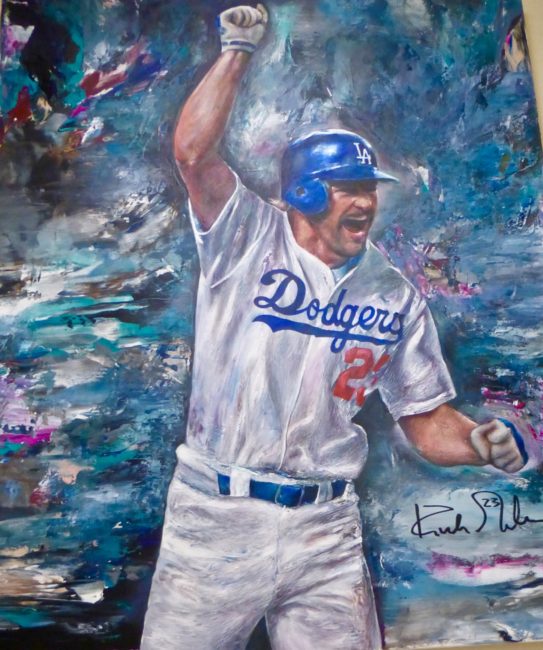 The entire “Dodgers Collection” gets my “Stamp” of approval.
The entire “Dodgers Collection” gets my “Stamp” of approval.
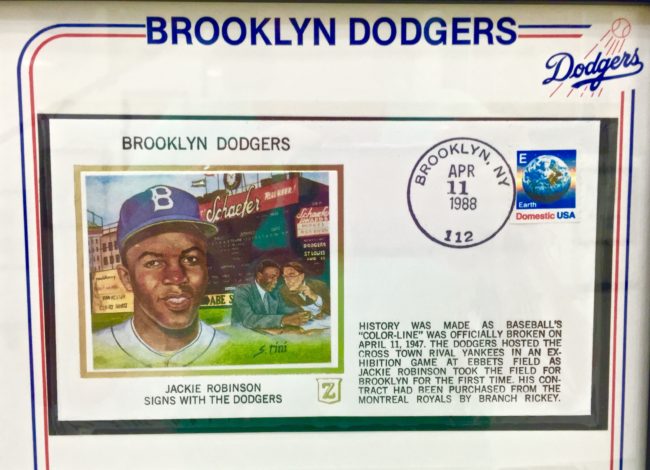 I think the museum should have a recording of Danny Kaye’s the “D•O•D•G•E•R•S Song” playing in this area (photo from internet). “Oh, Really? No, O’Malley.”
I think the museum should have a recording of Danny Kaye’s the “D•O•D•G•E•R•S Song” playing in this area (photo from internet). “Oh, Really? No, O’Malley.”
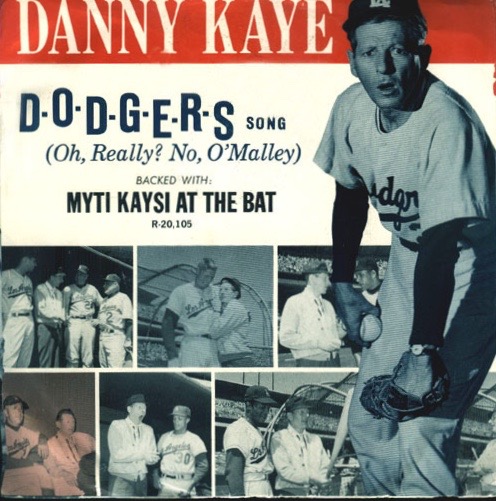 It was time to revisit New York to look at paraphernalia of the longest dynasty in sports history; the New York Yankees.
It was time to revisit New York to look at paraphernalia of the longest dynasty in sports history; the New York Yankees.
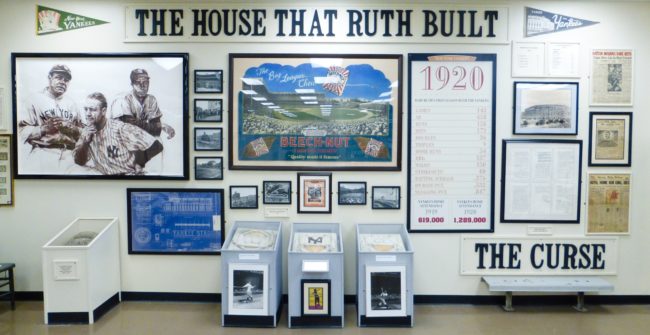 T They have the trophies to prove it (although these are from 1998…a Series to forget for Padre fans…and 1999).
T They have the trophies to prove it (although these are from 1998…a Series to forget for Padre fans…and 1999).
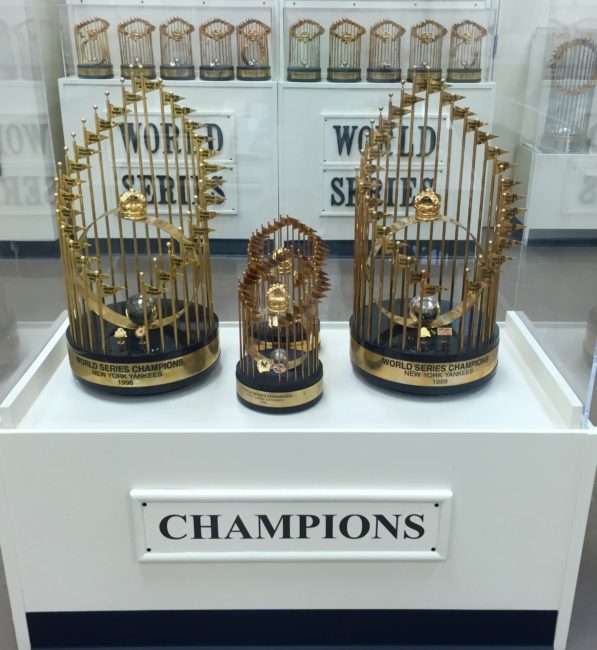 The first people I ran into were Babe (no, not that Babe)…
The first people I ran into were Babe (no, not that Babe)…
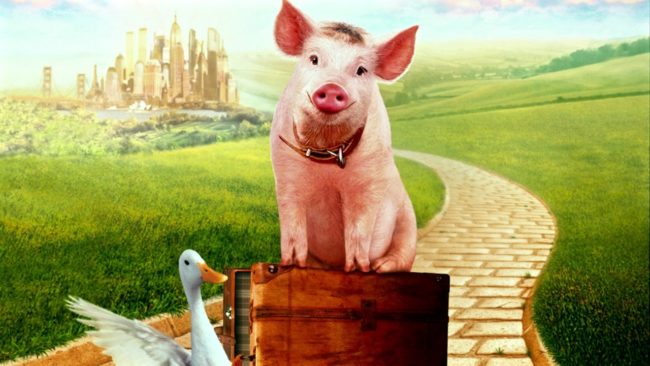 …and Lou. Just think…between the three of us we had 1,207 home runs.
…and Lou. Just think…between the three of us we had 1,207 home runs.
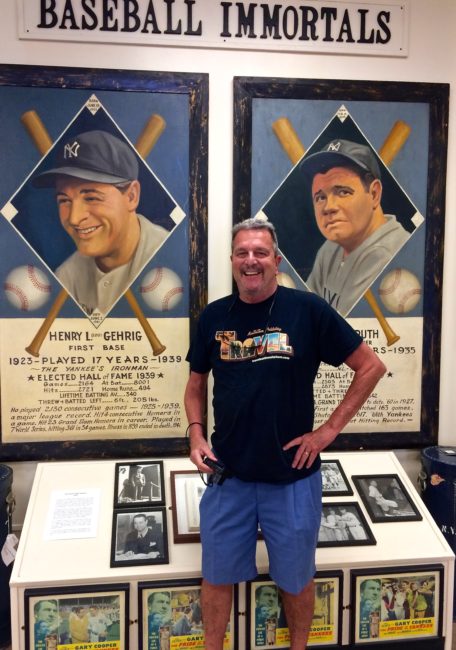 They even have Babe’s contract. I remembered Ruth’s famous quote when he was told that he made more money than the President of the United States: “I know, but I had a better year than Hoover.”
They even have Babe’s contract. I remembered Ruth’s famous quote when he was told that he made more money than the President of the United States: “I know, but I had a better year than Hoover.”
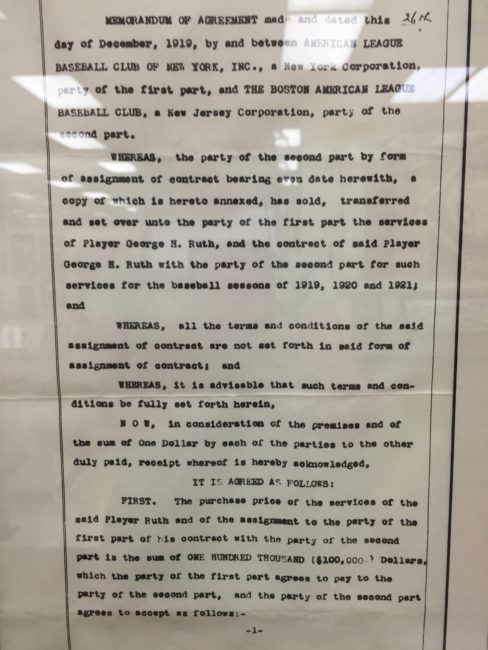 They also have the newspaper chronicling the day he passed away.
They also have the newspaper chronicling the day he passed away.
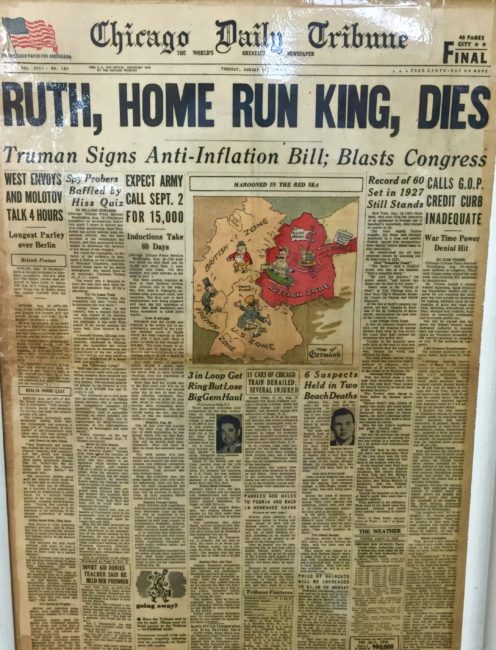 “The Mick” was on display. I’d love to have this painting over my mantle.
“The Mick” was on display. I’d love to have this painting over my mantle.
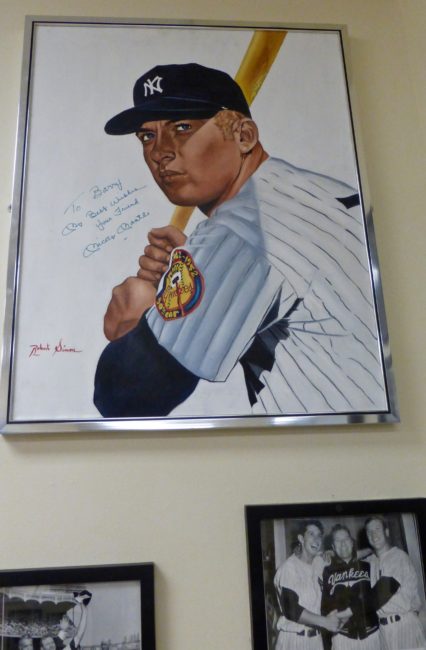 Like the Babe and Lou, Mickey passed away too soon.
Like the Babe and Lou, Mickey passed away too soon.
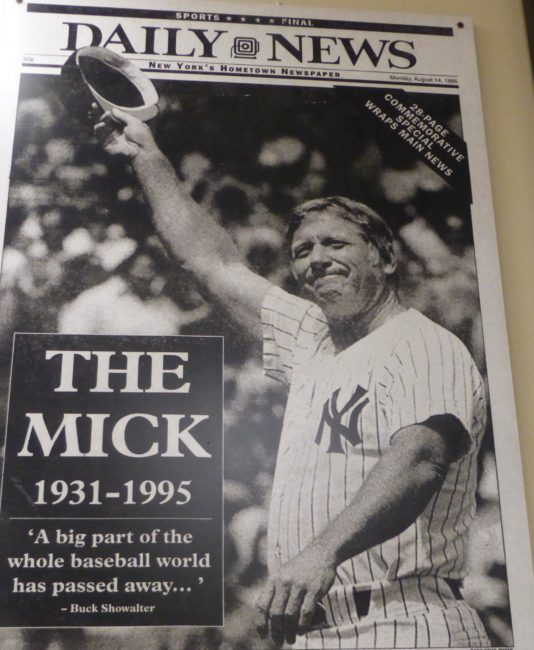 Where have you gone Joe DiMaggio? Right here at the Sports Museum of Los Angeles. You can get your “Joltin’ Joe” fix here. The uniform below is the last one he wore during the 1951 World Series.
Where have you gone Joe DiMaggio? Right here at the Sports Museum of Los Angeles. You can get your “Joltin’ Joe” fix here. The uniform below is the last one he wore during the 1951 World Series.
Now it was time to go to the movies…
…with vintage baseball movie posters.
There was also a bust of Lou Gehrig and a copy of his famed “Luckiest Man” speech.
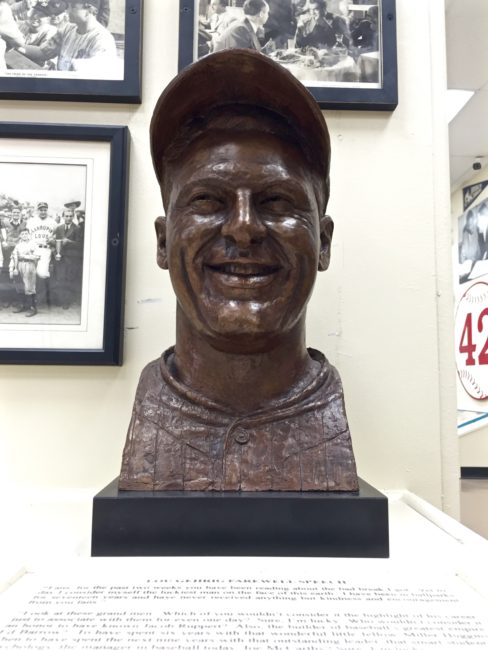 Tracy and I headed into another wing, where we found some old-time baseball jerseys…
Tracy and I headed into another wing, where we found some old-time baseball jerseys…
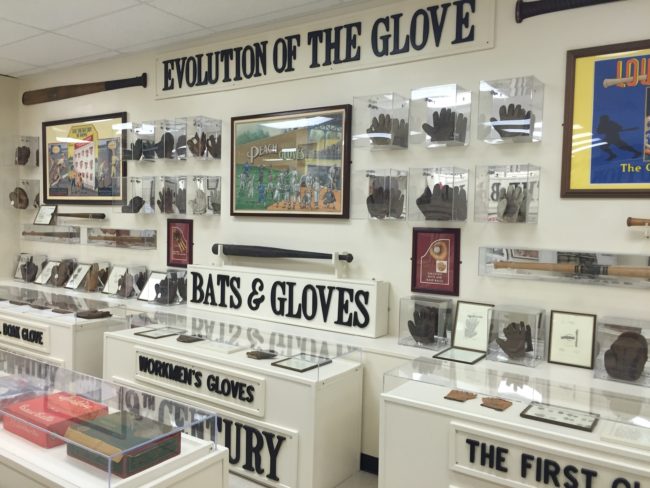 Are you ready for some football? Well, the museum contains some football items, too (in September it will open yet another wing featuring the history of the Cleveland-Los Angeles-St. Louis-Los Angeles Rams and lots of college football memorabilia).
Are you ready for some football? Well, the museum contains some football items, too (in September it will open yet another wing featuring the history of the Cleveland-Los Angeles-St. Louis-Los Angeles Rams and lots of college football memorabilia).
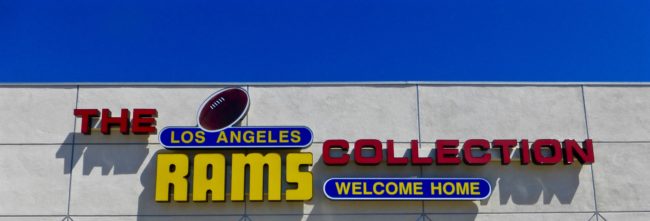 On the day we visited, the Packers and Bart Starr were featured. Since it was 95 degrees outside, there would be no “tundra.” I’d love to have this game.
On the day we visited, the Packers and Bart Starr were featured. Since it was 95 degrees outside, there would be no “tundra.” I’d love to have this game.
There were a couple of more interesting things to see…
…before moving on…
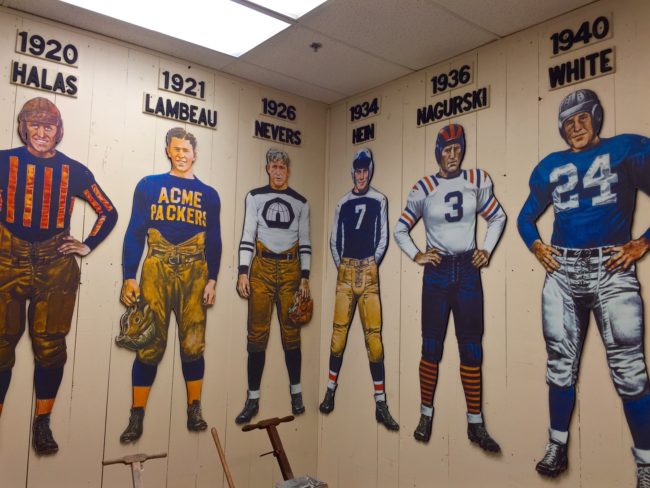 …to the “Black Pioneers of Sports” Collection, starting off with “The Negro Leagues.”
…to the “Black Pioneers of Sports” Collection, starting off with “The Negro Leagues.”
There stood a statue of the great Josh Gibson, who many consider the greatest baseball player of all time. He hit 100 home runs one year as a member of the Homestead Grays. Hall of Fame pitcher Walter Johnson once said, “Josh is worth $250,000 (Babe made 80 grand) to any big league team.” Unfortunately, integration didn’t come to baseball for many years, and Gibson died at the young age of 35.
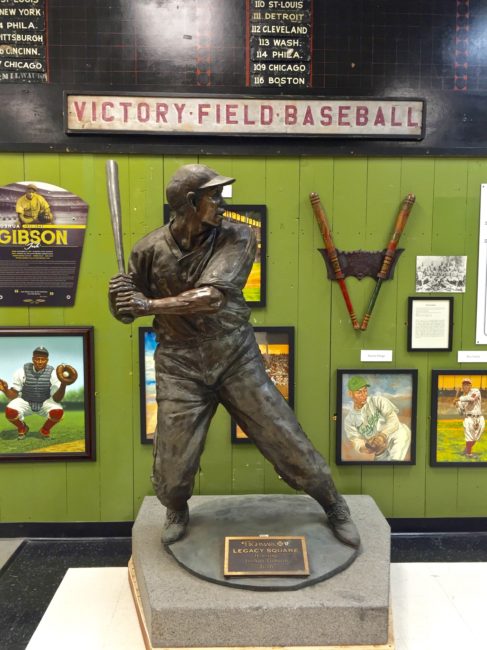
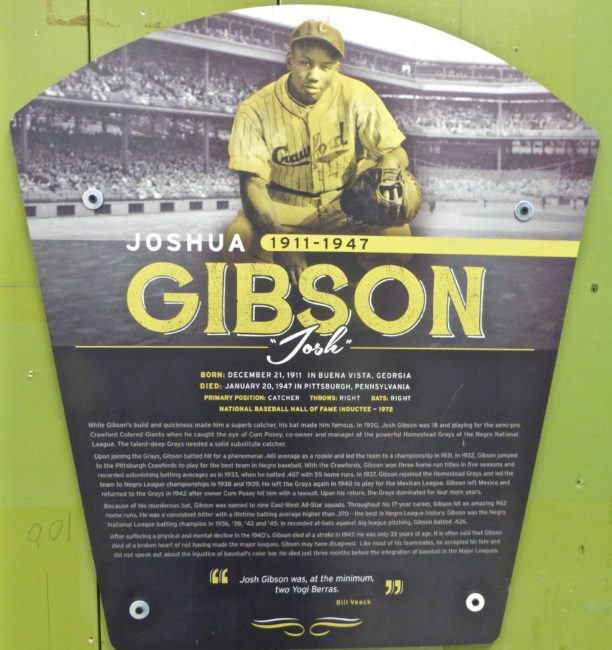 It’s because players like Gibson, pitcher Satchel Page and hundreds of others were not allowed to play in the big leagues, that I pretty much discount any Major League records until baseball became integrated in 1947 when Jackie Robinson came on the scene.
It’s because players like Gibson, pitcher Satchel Page and hundreds of others were not allowed to play in the big leagues, that I pretty much discount any Major League records until baseball became integrated in 1947 when Jackie Robinson came on the scene.
We also viewed statues of legendary Negro League players “Buck” Leonard and “Cool Papa” Bell.
I would love to spend some more time in this section on my next trip here.
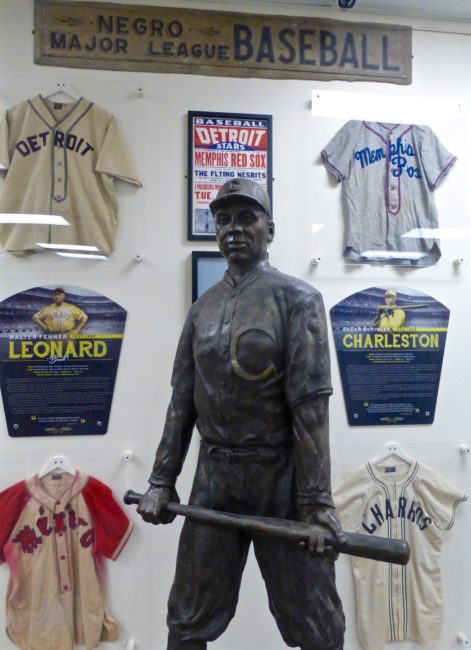 We headed over to catch some hoops. One of my favorite players was Wilt “the Stilt” Chamberlain, who once scored 100 points in a game. I had forgotten he was also once a member of the Harlem Globetrotters.
We headed over to catch some hoops. One of my favorite players was Wilt “the Stilt” Chamberlain, who once scored 100 points in a game. I had forgotten he was also once a member of the Harlem Globetrotters.
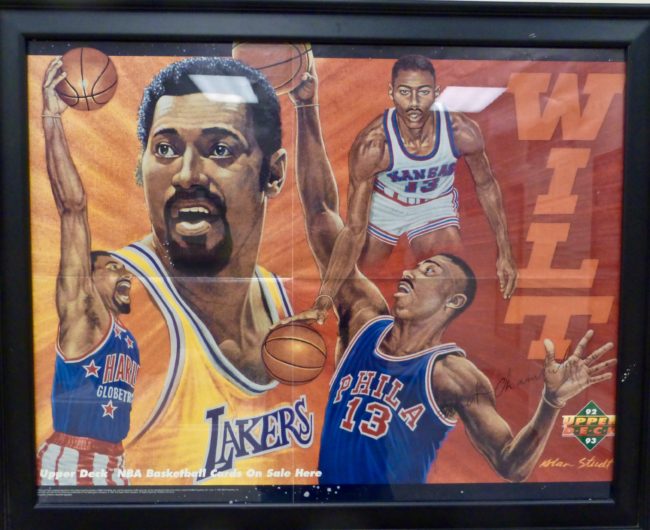 Tracy and I went on a fast break to the Basketball Room.
Tracy and I went on a fast break to the Basketball Room.
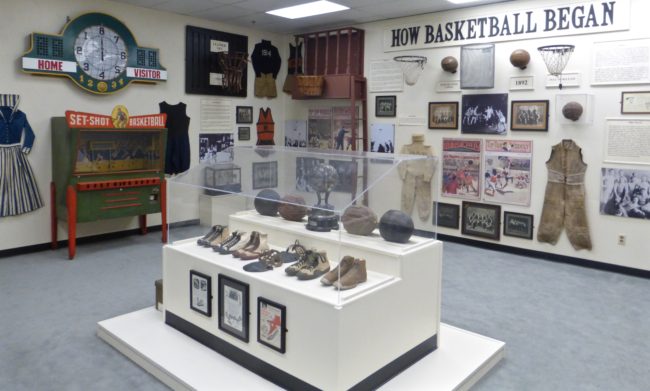 Of course, it would be tough to start a fast break with these baskets. I’m not yanking your chain either. “Hey, who brought the darned stick?”
Of course, it would be tough to start a fast break with these baskets. I’m not yanking your chain either. “Hey, who brought the darned stick?”
Boxing was next up, and it packed quite a punch…
…with a colorful exhibit.
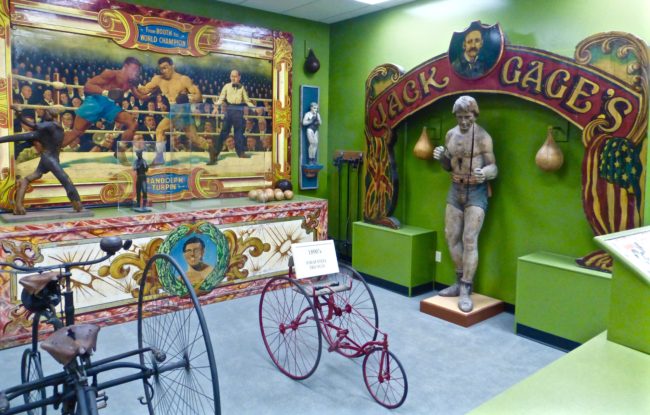 Tracy was getting a little punch drunk, so it was about time to throw in the towel. The final part of our excursion through sports history was a journey through a hodgepodge of fun stuff.
Tracy was getting a little punch drunk, so it was about time to throw in the towel. The final part of our excursion through sports history was a journey through a hodgepodge of fun stuff.
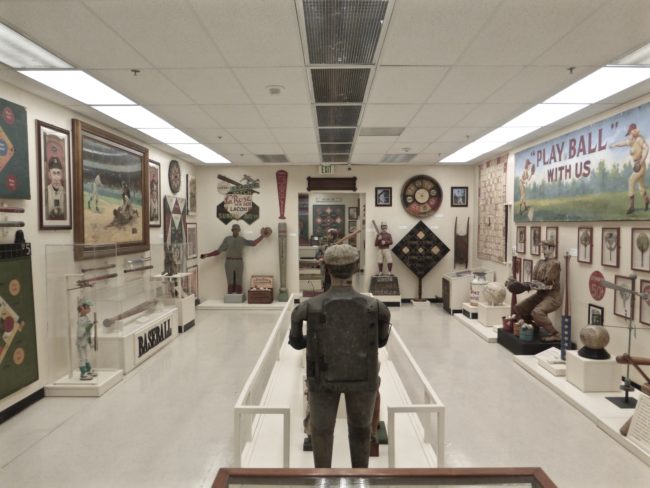 Subscriber Kevin C would love to get his hands on this vintage baseball pinball machine….or this cool arcade game.
Subscriber Kevin C would love to get his hands on this vintage baseball pinball machine….or this cool arcade game.
I only saw this movie about 100 times when I was a kid. “Thanks King!”
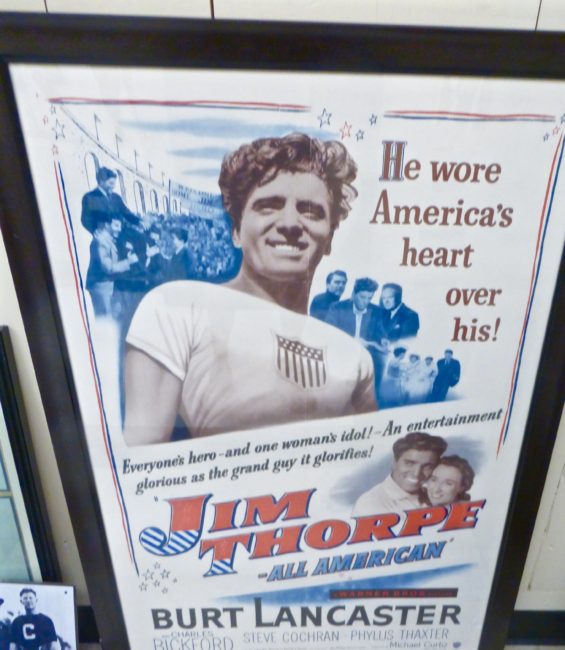 There were still movie posters (by the way, if you get the chance get your paws on a DVD of “Rhubarb,” about a cat who inherits a baseball team…it’s a “purrfect” baseball movie).
There were still movie posters (by the way, if you get the chance get your paws on a DVD of “Rhubarb,” about a cat who inherits a baseball team…it’s a “purrfect” baseball movie).
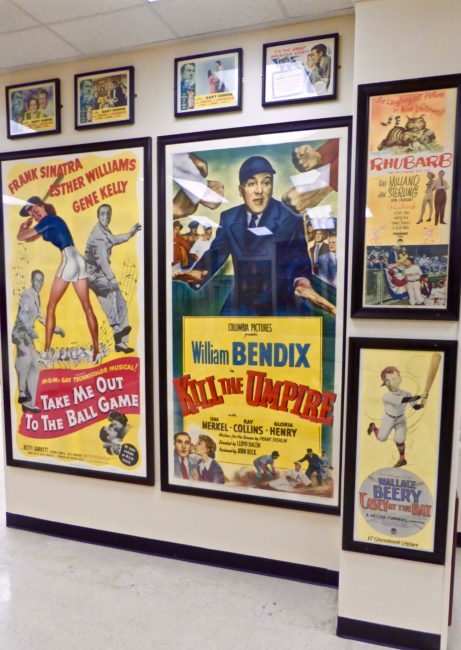 Old baseball artifacts abound here. A painting of Cy Young caught our eye. It should win an award.
Old baseball artifacts abound here. A painting of Cy Young caught our eye. It should win an award.
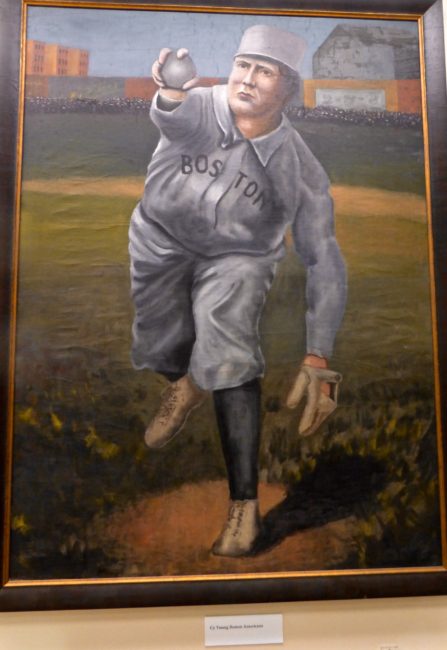 If only I had read this book in the Pony League.
If only I had read this book in the Pony League.
…and we were done for our day at the museum.
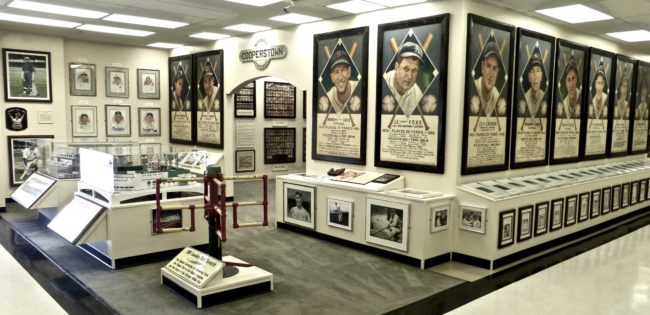 I do not have enough superlatives to describe the Sports Museum of Los Angeles. As a sports fan since I was old enough to hold a transistor radio to my ear (thanks Vin!)…
I do not have enough superlatives to describe the Sports Museum of Los Angeles. As a sports fan since I was old enough to hold a transistor radio to my ear (thanks Vin!)…
…I had a ball (of all shapes and sizes)! I was overwhelmed by the number of fascinating items this museum houses.
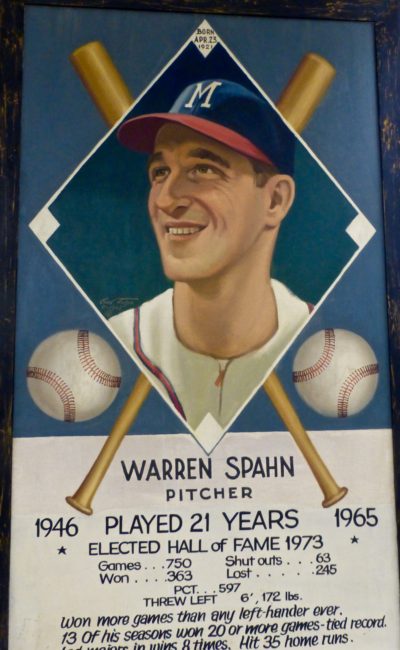 One of my childhood heroes, Tommy Davis of the Los Angeles Dodgers, said, “Nothing like it anywhere else. It’s the best thing I’ve ever seen. There’s so much information on the history of baseball and all the great players. It would take a week to view it all.” Amen Tommy!!!
One of my childhood heroes, Tommy Davis of the Los Angeles Dodgers, said, “Nothing like it anywhere else. It’s the best thing I’ve ever seen. There’s so much information on the history of baseball and all the great players. It would take a week to view it all.” Amen Tommy!!!
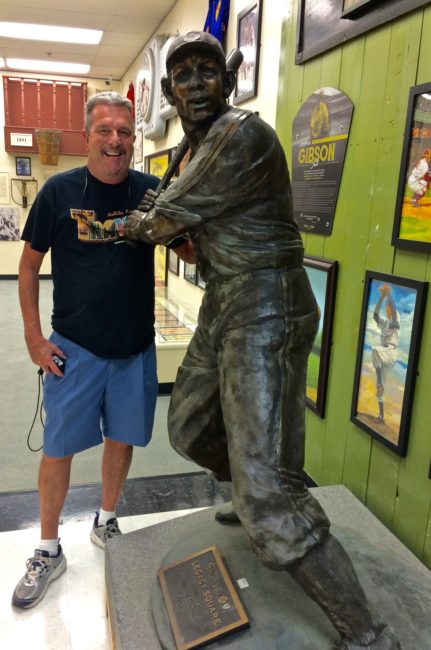 If you live in Los Angeles or are a visiting sports fan, I would put the Sports Museum of Los Angeles on your high priority of places to see.
If you live in Los Angeles or are a visiting sports fan, I would put the Sports Museum of Los Angeles on your high priority of places to see.
Tell your friends. Tell your neighbors. Your kids will love it. You will love it. Your grandparents will love it. Play ball!
Sports Museum of Los Angeles
1900 S Main Street
Los Angeles, California 90007
Hours: Saturday 10 a.m. – 5 p.m. • Sunday 1 a.m. – 5 p.m.
(Starting August 27, the museum will only be open Saturdays)
Cost: Adults: $15 • Seniors (65 and older) and Students with ID $12 • Kids 5-12 $9
Parking: (enter from Main Street) $8
www.sportsmuseumla.com

